f718b6df9aefa9b9b7fa8215098f3db5.ppt
- Количество слайдов: 197
 Development of Indian Nationalism and Independence With Detailed Focus on Role of Gandhi
Development of Indian Nationalism and Independence With Detailed Focus on Role of Gandhi
 Timeline Overview Summary Slides
Timeline Overview Summary Slides
 INDIA • Nationalist Challenge to the British Raj – India colonized long before Africa, Asia • Was first to establish independence movements • Western-educated minorities organized politically • Sought to bring about the end or modification of colonial regimes – Indian National Congress • • • Regional associations of Western-educated Indians Most often urbanized elite Formed Indian National Congress party in 1885 Primary function of early party was to present grievances to British Most of the issues concerned the Indian elite, not the poor Despite limited aims, Congress party allowed the formation of Indian identity • Social Foundations of a Mass Movement – British economic and social policies • Helped the Congress party attract a mass following • Marginalized all Indians including elite – Indians • Supported the massive costs for the colonial army, high-salaried bureaucrats • Tolerated the importation of British-manufactured goods. – Problems among the peasantry including shortfalls of food supplies • Induced nationalists to blame the British policies • Encouraged peasants to shift from the production of food to commercial crops.
INDIA • Nationalist Challenge to the British Raj – India colonized long before Africa, Asia • Was first to establish independence movements • Western-educated minorities organized politically • Sought to bring about the end or modification of colonial regimes – Indian National Congress • • • Regional associations of Western-educated Indians Most often urbanized elite Formed Indian National Congress party in 1885 Primary function of early party was to present grievances to British Most of the issues concerned the Indian elite, not the poor Despite limited aims, Congress party allowed the formation of Indian identity • Social Foundations of a Mass Movement – British economic and social policies • Helped the Congress party attract a mass following • Marginalized all Indians including elite – Indians • Supported the massive costs for the colonial army, high-salaried bureaucrats • Tolerated the importation of British-manufactured goods. – Problems among the peasantry including shortfalls of food supplies • Induced nationalists to blame the British policies • Encouraged peasants to shift from the production of food to commercial crops.
 INDIAN OPTIONS • The Rise of Militant Nationalism – Some nationalists such as B. G. Tilak emphasized Hindusim • • Tilak, supporters used Hindu religious festivals as means of recruitment. Tilak urged the boycott of British manufactured goods Tilak's conservative Hinduism frightened moderates, Muslims, Sikhs Tilak's support for violence led to his arrest, deportation • • • Embraced terrorism as a means of ending British rule Terrorist groups favored secret organizations Targeted British officials and public buildings British suppression, lack of mass support reduced threats Peaceful schemes for protest drew support from Tilak, terrorists Congress Party lawyers emerged as leaders of nationalist movement – Some Hindus – All India Muslim League and Muhammad Ali Jinnah • League founded in 1906 to represent Muslim interests • Jinnah joined in 1916 and helped bring Congress Party and League together • The Emergence of Gandhi and the Nationalist Struggle – India played a significant role in World War I • Even the nationalist leaders of India supported the war effort • Wartime inflation reduced standards of living among the Indian peasants • Produced famine in some regions. – Following the war • Nationalists were frustrated by the British refusal to move directly toward independence. • Initial promise of the Montagu-Chelmsford reforms of 1919 • Offset by the Rowlatt Act, which limited Indian civil rights. – Frustrations led to the Rise of Gandhi • • • Permitted Gandhi to build a nationwide protest against colonialism Gandhi combined the qualities of a Hindu mystic with the acumen of a Western-educated lawyer Both peasants and the middle classes supported his leadership His boycotts, campaigns of civil resistance made him acceptable to both radical, moderate nationalists As a Hindu mystic, Gandhi could mobilize widespread support for his movement
INDIAN OPTIONS • The Rise of Militant Nationalism – Some nationalists such as B. G. Tilak emphasized Hindusim • • Tilak, supporters used Hindu religious festivals as means of recruitment. Tilak urged the boycott of British manufactured goods Tilak's conservative Hinduism frightened moderates, Muslims, Sikhs Tilak's support for violence led to his arrest, deportation • • • Embraced terrorism as a means of ending British rule Terrorist groups favored secret organizations Targeted British officials and public buildings British suppression, lack of mass support reduced threats Peaceful schemes for protest drew support from Tilak, terrorists Congress Party lawyers emerged as leaders of nationalist movement – Some Hindus – All India Muslim League and Muhammad Ali Jinnah • League founded in 1906 to represent Muslim interests • Jinnah joined in 1916 and helped bring Congress Party and League together • The Emergence of Gandhi and the Nationalist Struggle – India played a significant role in World War I • Even the nationalist leaders of India supported the war effort • Wartime inflation reduced standards of living among the Indian peasants • Produced famine in some regions. – Following the war • Nationalists were frustrated by the British refusal to move directly toward independence. • Initial promise of the Montagu-Chelmsford reforms of 1919 • Offset by the Rowlatt Act, which limited Indian civil rights. – Frustrations led to the Rise of Gandhi • • • Permitted Gandhi to build a nationwide protest against colonialism Gandhi combined the qualities of a Hindu mystic with the acumen of a Western-educated lawyer Both peasants and the middle classes supported his leadership His boycotts, campaigns of civil resistance made him acceptable to both radical, moderate nationalists As a Hindu mystic, Gandhi could mobilize widespread support for his movement
 Defining Nationalism and Causes of Nationalism in India
Defining Nationalism and Causes of Nationalism in India
 Nationalism – the loyalty to a group with whom one shares a common history, culture, and/or religion.
Nationalism – the loyalty to a group with whom one shares a common history, culture, and/or religion.
![Nationalism is……………… [1]the desire to achieve political independence, especially by a country under foreign Nationalism is……………… [1]the desire to achieve political independence, especially by a country under foreign](https://present5.com/presentation/f718b6df9aefa9b9b7fa8215098f3db5/image-7.jpg) Nationalism is……………… [1]the desire to achieve political independence, especially by a country under foreign control or by a people with a separate identity and culture but no state of their own; [2]proud loyalty and devotion to a nation; [3]excessive or fanatical devotion to a nation and its interests, often associated with a belief that one country is superior to all others.
Nationalism is……………… [1]the desire to achieve political independence, especially by a country under foreign control or by a people with a separate identity and culture but no state of their own; [2]proud loyalty and devotion to a nation; [3]excessive or fanatical devotion to a nation and its interests, often associated with a belief that one country is superior to all others.
 Causes of Indian Nationalism: 1. 2. 3. 4. 5. 6. Discontent with British rule India unified Leadership Common language New print culture Nationalist organizations
Causes of Indian Nationalism: 1. 2. 3. 4. 5. 6. Discontent with British rule India unified Leadership Common language New print culture Nationalist organizations
 Beginnings of Indian Nationalism
Beginnings of Indian Nationalism
 • Nationalism in India began in the 1800 s. • Indians did not like being under British colonial rule because: – They were treated badly – British got the best jobs – British got the best education – Indian craftsmen were not allowed to run traditional businesses because they would compete with British businesses.
• Nationalism in India began in the 1800 s. • Indians did not like being under British colonial rule because: – They were treated badly – British got the best jobs – British got the best education – Indian craftsmen were not allowed to run traditional businesses because they would compete with British businesses.
 First Indian Nationalists • Were upper class • Were English educated • Many of them from urban areas like Bombay, Madras, and Calcutta • Some were trained in British law • Some were members of the civil service • Many preferred reform to revolution
First Indian Nationalists • Were upper class • Were English educated • Many of them from urban areas like Bombay, Madras, and Calcutta • Some were trained in British law • Some were members of the civil service • Many preferred reform to revolution
 Beginnings of Indian Nationalism • The new Indian middle classes slowly grew tired of the injustice of British rule • Dreamed of ending imperial rule • The new nationalists wrote in both English and their regional languages and turned to aspects of Indian tradition, especially Hinduism, as a rallying ground for national pride – Ignored or overlooked Muslim leaders
Beginnings of Indian Nationalism • The new Indian middle classes slowly grew tired of the injustice of British rule • Dreamed of ending imperial rule • The new nationalists wrote in both English and their regional languages and turned to aspects of Indian tradition, especially Hinduism, as a rallying ground for national pride – Ignored or overlooked Muslim leaders
 Pair-Share Activity: What is Macaulay’s quote saying about the Indian people and why? In 1835, Thomas Macaulay articulated the goals of British colonial imperialism most succinctly: "We must do our best to form a class who may be interpreters between us and the millions whom we govern, a class of persons Indian in blood and colour, but English in taste, in opinions, words and intellect. "
Pair-Share Activity: What is Macaulay’s quote saying about the Indian people and why? In 1835, Thomas Macaulay articulated the goals of British colonial imperialism most succinctly: "We must do our best to form a class who may be interpreters between us and the millions whom we govern, a class of persons Indian in blood and colour, but English in taste, in opinions, words and intellect. "
 Preserving Indian Culture
Preserving Indian Culture
 Acts to Preserve Indian Culture • Indian teachers, writers, and journalists wanted to preserve their own culture. • In the early 1800 s, when the British established a college in Calcutta, a publishing house was opened too. • It published Western books, but also books on India’s ancient language of Sanskrit and dictionaries and grammar books for many of the Indian languages. • This spread to other regions of India and led to writers searching for the Indian identity in modern novels and poetry. • Indians began writing historical romances and epics and usually in their own regional language.
Acts to Preserve Indian Culture • Indian teachers, writers, and journalists wanted to preserve their own culture. • In the early 1800 s, when the British established a college in Calcutta, a publishing house was opened too. • It published Western books, but also books on India’s ancient language of Sanskrit and dictionaries and grammar books for many of the Indian languages. • This spread to other regions of India and led to writers searching for the Indian identity in modern novels and poetry. • Indians began writing historical romances and epics and usually in their own regional language.
 Example of Preserving Culture: Tagore
Example of Preserving Culture: Tagore
 Rabindranath Tagore • Most illustrious Indian author---great writer and poet • Was a social reformer, spiritual leader, educator, philosopher, and international spokesperson on morality • His life’s mission was to promote pride in Indian culture in the face of British domination • He wrote a widely popular novel in which he portrayed the love-hate relationship of Indians towards Britain. • Reflected how Indian people struggled with defining their identity as they admired and imitated the British, but lost some of their Indian traditions • Wanted world peace and a union of the East and West
Rabindranath Tagore • Most illustrious Indian author---great writer and poet • Was a social reformer, spiritual leader, educator, philosopher, and international spokesperson on morality • His life’s mission was to promote pride in Indian culture in the face of British domination • He wrote a widely popular novel in which he portrayed the love-hate relationship of Indians towards Britain. • Reflected how Indian people struggled with defining their identity as they admired and imitated the British, but lost some of their Indian traditions • Wanted world peace and a union of the East and West
 Tagore • Strove to have a balance between Western influence and ancient customs • He was respected and followed by both British colonizers and Indians for his work • Friend of Gandhi • Preferred to stay out of politics
Tagore • Strove to have a balance between Western influence and ancient customs • He was respected and followed by both British colonizers and Indians for his work • Friend of Gandhi • Preferred to stay out of politics
 Pair-Share Activity: Select one of the two quotes. What does Tagore mean? How does this relate to his work? • “It is my conviction that • Bigotry tries to keep my countrymen will truth safe in its hand truly gain their India by with a grip that kills it. ” fighting against the education that teaches them that a country is greater than the ideals of humanity. ”
Pair-Share Activity: Select one of the two quotes. What does Tagore mean? How does this relate to his work? • “It is my conviction that • Bigotry tries to keep my countrymen will truth safe in its hand truly gain their India by with a grip that kills it. ” fighting against the education that teaches them that a country is greater than the ideals of humanity. ”
 Preserving Indian Culture: Another Example ---Nationalist Newspapers
Preserving Indian Culture: Another Example ---Nationalist Newspapers
 Nationalist Newspapers • Printed in various regional Indian languages • Common medium used to arouse mass support for the nationalist causes • The newspapers reached the lower middle class---tens of thousands of Indians who did not know English • Examples: – Kesari or The Lion Newspaper---journalist Tilak used innuendo to convey negative feelings about the British without writing anything directly disloyal – Swadeshamitram or The Friend of Our Nation---editor organized literary meetings to discuss poetry and politics
Nationalist Newspapers • Printed in various regional Indian languages • Common medium used to arouse mass support for the nationalist causes • The newspapers reached the lower middle class---tens of thousands of Indians who did not know English • Examples: – Kesari or The Lion Newspaper---journalist Tilak used innuendo to convey negative feelings about the British without writing anything directly disloyal – Swadeshamitram or The Friend of Our Nation---editor organized literary meetings to discuss poetry and politics
 Ram Mohun Roy and Indian Nationalism
Ram Mohun Roy and Indian Nationalism
 Ram Mohun Roy (1772 -1833) • well-educated Indian who began a campaign to modernize India • he was opposed to India’s caste system (social class system that ties a person to the social class they are into for life: based on Hindu beliefs) opposed to child marriages and widow suicides believed these practices needed to be changed if India wanted to be free from rule by outsiders • •
Ram Mohun Roy (1772 -1833) • well-educated Indian who began a campaign to modernize India • he was opposed to India’s caste system (social class system that ties a person to the social class they are into for life: based on Hindu beliefs) opposed to child marriages and widow suicides believed these practices needed to be changed if India wanted to be free from rule by outsiders • •
 • Roy was an avowed “modernist” Wanted to meld the best of European-Christian morality and thought with best of Hindu piety and thought “father of modern India; he was influenced by Christianity, accepted monotheism (but not divinity of Jesus), and worked on reforms
• Roy was an avowed “modernist” Wanted to meld the best of European-Christian morality and thought with best of Hindu piety and thought “father of modern India; he was influenced by Christianity, accepted monotheism (but not divinity of Jesus), and worked on reforms
 Combined Western and Indian Ideas: Ram Mohun Roy combined both views and because of his influence, he is often hailed as the founder of Indian nationalism This statue of Raja Rammohun Roy stands outside Bristol Cathedral.
Combined Western and Indian Ideas: Ram Mohun Roy combined both views and because of his influence, he is often hailed as the founder of Indian nationalism This statue of Raja Rammohun Roy stands outside Bristol Cathedral.
 The Rise of Indian Nationalism • Groups in India found British rule deeply disturbing • Indian elites and middle classes lacked opportunities • Indians had little power to influence decisions at higher levels of government Nationalist Movement Activating Movement • Nationalist movement did not take off until Indians saw themselves as having same rights as Europeans • Idea first expressed by reformer Ram Mohun Roy, 1820 s • Felt British violating Indian’s rights, including free speech, religion • Roy wrote texts, opened schools to spread nationalist ideas • Despite his efforts, took several decades for movement to activate • 1885, Indian National Congress, first nationalist group, founded by English-speaking Indians Initial requests of the Congress to British were modest, such as more positions for Indians in the ICS, and better representation on government councils.
The Rise of Indian Nationalism • Groups in India found British rule deeply disturbing • Indian elites and middle classes lacked opportunities • Indians had little power to influence decisions at higher levels of government Nationalist Movement Activating Movement • Nationalist movement did not take off until Indians saw themselves as having same rights as Europeans • Idea first expressed by reformer Ram Mohun Roy, 1820 s • Felt British violating Indian’s rights, including free speech, religion • Roy wrote texts, opened schools to spread nationalist ideas • Despite his efforts, took several decades for movement to activate • 1885, Indian National Congress, first nationalist group, founded by English-speaking Indians Initial requests of the Congress to British were modest, such as more positions for Indians in the ICS, and better representation on government councils.
 Raja Ram Mohan Roy • Sought to counter the criticisms of Hinduism made by the British missionaries • Founded the Brahmo Samaj in 1828 as a new religion with Christian-style services. • Encouraged Indians to be egalitarians----to move away from the caste system and accept that all people are equal • Encouraged Indians to do more social services for the poor and to reject the belief that their suffering was okay due to karma and dharma
Raja Ram Mohan Roy • Sought to counter the criticisms of Hinduism made by the British missionaries • Founded the Brahmo Samaj in 1828 as a new religion with Christian-style services. • Encouraged Indians to be egalitarians----to move away from the caste system and accept that all people are equal • Encouraged Indians to do more social services for the poor and to reject the belief that their suffering was okay due to karma and dharma
 Ram Mohun Roy • Roy criticized what he saw as the idolatry and superstition of traditional Hinduism and he even detested many customs that he felt were unnecessary such as the sati or suttee custom. • Sati- A custom of widow burning upon the funeral pyres of their deceased husbands which was outlawed in 1829. • Ram also addressed his concerns to the British about a new Sanskrit School in Calcutta, in the Letter to Lord Amherst, Roy said his country was grateful that they and they British were working together and that they are gifting the school, but, that the people expected to be taught by Britain’s educated scholars. • Roy felt that the classical Indian literature would not prepare the younger new generations of the Bengal people and he proposed, instead for a modern Western curriculum of study. • Roy led another protest against the outmoded British legal and revenue administration in India.
Ram Mohun Roy • Roy criticized what he saw as the idolatry and superstition of traditional Hinduism and he even detested many customs that he felt were unnecessary such as the sati or suttee custom. • Sati- A custom of widow burning upon the funeral pyres of their deceased husbands which was outlawed in 1829. • Ram also addressed his concerns to the British about a new Sanskrit School in Calcutta, in the Letter to Lord Amherst, Roy said his country was grateful that they and they British were working together and that they are gifting the school, but, that the people expected to be taught by Britain’s educated scholars. • Roy felt that the classical Indian literature would not prepare the younger new generations of the Bengal people and he proposed, instead for a modern Western curriculum of study. • Roy led another protest against the outmoded British legal and revenue administration in India.
 Brahmo Samaj • Roy founded the Brahmo Samaj or (Divine Society/Society of Brahma) in 1828 • This society attracted Indians who sought to reconcile the values of the West with the religious traditions of India. • This Society is what also supported the bans and changes in Hindu customs that Roy wanted. • They outlawed many of the abuses in India such as slavery and abuses to women, prohibitions against widows remarrying were revoked in 1856 and female infanticide was made a crime in 1870.
Brahmo Samaj • Roy founded the Brahmo Samaj or (Divine Society/Society of Brahma) in 1828 • This society attracted Indians who sought to reconcile the values of the West with the religious traditions of India. • This Society is what also supported the bans and changes in Hindu customs that Roy wanted. • They outlawed many of the abuses in India such as slavery and abuses to women, prohibitions against widows remarrying were revoked in 1856 and female infanticide was made a crime in 1870.
 Pair-Share Activity • Of all the things Ram Mohun Roy did, which do you think was most important and why?
Pair-Share Activity • Of all the things Ram Mohun Roy did, which do you think was most important and why?
 Impact of Roy • Many Indian intellectuals turned to the Western secular values and nationalism as the way to reclaim India. • The western education spread just as Roy ad imagine played an important role as it was aided by European/American missionaries. • Roy had opened many colleges with these western education such as in 1816 the Hindu College in Calcutta, Bethune College in Calcutta, the first secular school for Indian women in 1849. • Three other universities were established in India 1857 and by 1870 there were over 24, 000 elementary and secondary schools.
Impact of Roy • Many Indian intellectuals turned to the Western secular values and nationalism as the way to reclaim India. • The western education spread just as Roy ad imagine played an important role as it was aided by European/American missionaries. • Roy had opened many colleges with these western education such as in 1816 the Hindu College in Calcutta, Bethune College in Calcutta, the first secular school for Indian women in 1849. • Three other universities were established in India 1857 and by 1870 there were over 24, 000 elementary and secondary schools.
 Impact of Ram Roy: Independence Organizations Formed Indian National Congress • Comprised of Middle Class professionals and lawyers educated in England • Majority of members Hindu • Wanted greater selfgovernment for Indians in India Muslim League • Comprised of Middle Class professionals and lawyers educated in England • Members Muslim • Wanted independence for India and creation of 2 countries: India and Pakistan
Impact of Ram Roy: Independence Organizations Formed Indian National Congress • Comprised of Middle Class professionals and lawyers educated in England • Majority of members Hindu • Wanted greater selfgovernment for Indians in India Muslim League • Comprised of Middle Class professionals and lawyers educated in England • Members Muslim • Wanted independence for India and creation of 2 countries: India and Pakistan
 Indian National Congress
Indian National Congress
 Indian National Congress (INC) • Due to the slow pace of British reform in India, many of the nationalists became convinced that relying on British good will was a lost cause • 1885 ---a small group of Indians met in Bombay and formed the Indian National Congress • It did not immediately call for independence, but for a share in the governing process
Indian National Congress (INC) • Due to the slow pace of British reform in India, many of the nationalists became convinced that relying on British good will was a lost cause • 1885 ---a small group of Indians met in Bombay and formed the Indian National Congress • It did not immediately call for independence, but for a share in the governing process
 The Indian National Congress 1885 The Indian National Congress was founded in Bombay. swaraj “independence. ” * the goal of the movement.
The Indian National Congress 1885 The Indian National Congress was founded in Bombay. swaraj “independence. ” * the goal of the movement.
 Indian National Congress • Goals: Democracy, Local Self-Rule, Prevent mass peasant uprising (like China) by keeping power centered on middle class leaders.
Indian National Congress • Goals: Democracy, Local Self-Rule, Prevent mass peasant uprising (like China) by keeping power centered on middle class leaders.
 Indian National Congress • Had problems due to religious differences between Muslims and Hindus members • INC sought independence for all Indians regardless of class or religions • But its leaders were Hindus and not Muslims • INC reflected more Hindu concerns
Indian National Congress • Had problems due to religious differences between Muslims and Hindus members • INC sought independence for all Indians regardless of class or religions • But its leaders were Hindus and not Muslims • INC reflected more Hindu concerns
 Indian National Congress 1885 • Made up of Hindus; called for self-government • Upset that Britain segregated Bengal (Indian city) into Muslim section and Hindu section in 1905 • INC led acts of violence against British in Bengal • 1911 Britain changed the order of segregation
Indian National Congress 1885 • Made up of Hindus; called for self-government • Upset that Britain segregated Bengal (Indian city) into Muslim section and Hindu section in 1905 • INC led acts of violence against British in Bengal • 1911 Britain changed the order of segregation
 Examples for Indian National Congress: Gandhi and Jawaharlal Nehru
Examples for Indian National Congress: Gandhi and Jawaharlal Nehru
 Mohandas Gandhi • Studied law in England, practiced in South Africa • Joined the INC before WWI • Became leader of the INC because he was better able to relate to the problems of the common people • Believed in the idea of non-violent resistance (Satyagraha)
Mohandas Gandhi • Studied law in England, practiced in South Africa • Joined the INC before WWI • Became leader of the INC because he was better able to relate to the problems of the common people • Believed in the idea of non-violent resistance (Satyagraha)
 Nehru • Joined the INC in 1930 s • New kind of Indian politician---upper class and intellectual • Differed from Gandhi who was more religious and traditional, while Nehru was secular, Western, and modern
Nehru • Joined the INC in 1930 s • New kind of Indian politician---upper class and intellectual • Differed from Gandhi who was more religious and traditional, while Nehru was secular, Western, and modern
 Nehru Jawaharlal Nehru. Also a high-caste Hindu educated in Britain, • - Nehru was a practical political leader with socialist leanings. • - He accepted Gandhi's ideas of passive resistance and aiding untouchables, but he rejected Gandhi's proposal for hand production. • - Instead, Nehru urged industrialization to develop India's economy and raise living standards.
Nehru Jawaharlal Nehru. Also a high-caste Hindu educated in Britain, • - Nehru was a practical political leader with socialist leanings. • - He accepted Gandhi's ideas of passive resistance and aiding untouchables, but he rejected Gandhi's proposal for hand production. • - Instead, Nehru urged industrialization to develop India's economy and raise living standards.
 Muslim League
Muslim League
 The Muslim League 1905 partition of Bengal based on religions and languages. 1906 creation of the Muslim League.
The Muslim League 1905 partition of Bengal based on religions and languages. 1906 creation of the Muslim League.
 The Muslim League Forms Goals: • Protect the interests, liberties and rights of Muslims • Promote an understanding between the Muslim community and other Indians - discourage violence. • Educating the Muslim and Indian community at large on the actions of the government
The Muslim League Forms Goals: • Protect the interests, liberties and rights of Muslims • Promote an understanding between the Muslim community and other Indians - discourage violence. • Educating the Muslim and Indian community at large on the actions of the government
 Muslim League • Strongest support came from Muslims who were frightened of Hindu domination • But many Muslims were also members of the Indian National Congress too • Initially the Muslim League focused on protesting Muslim rights and promoting understanding between the different religious groups • There was no notion of creating a separate state for Muslims until the 1920 s when the religious differences developed
Muslim League • Strongest support came from Muslims who were frightened of Hindu domination • But many Muslims were also members of the Indian National Congress too • Initially the Muslim League focused on protesting Muslim rights and promoting understanding between the different religious groups • There was no notion of creating a separate state for Muslims until the 1920 s when the religious differences developed
 Muslim League 1906 • Made up of Muslims • Also called for selfgovernment • • Also participated in acts of violence against British in India Also upset about segregation of Bengal in 1905
Muslim League 1906 • Made up of Muslims • Also called for selfgovernment • • Also participated in acts of violence against British in India Also upset about segregation of Bengal in 1905
 Indian Nationalism Grows • Indian National Congress (Hindus)/Muslim League (Muslims) Found Common Ground • Both worked together towards Indian Independence
Indian Nationalism Grows • Indian National Congress (Hindus)/Muslim League (Muslims) Found Common Ground • Both worked together towards Indian Independence
 Example: Mohammed Ali Jinnah and Muslim League
Example: Mohammed Ali Jinnah and Muslim League
 Muhammad Ali Jinnah • Leader of the Muslim League who pushed for a separate country for Muslim Indians.
Muhammad Ali Jinnah • Leader of the Muslim League who pushed for a separate country for Muslim Indians.
 Muhammad Ali Jinnah A. Middle Class lawyer educated in Britain B. First supported Hindu. Muslim Unity – called “Ambassador of Hindu. Muslim Unity” C. Proposed Lucknow Pact
Muhammad Ali Jinnah A. Middle Class lawyer educated in Britain B. First supported Hindu. Muslim Unity – called “Ambassador of Hindu. Muslim Unity” C. Proposed Lucknow Pact
 Muhammad Ali Jinnah D. Disagreement with Gandhi led to Muslim- Congress split E. Jinnah began to fear Hindu domination of Congress – A “Hindu Raj” F. Began to support the idea for an independent Muslim homeland, Pakistan or “land of the pure”.
Muhammad Ali Jinnah D. Disagreement with Gandhi led to Muslim- Congress split E. Jinnah began to fear Hindu domination of Congress – A “Hindu Raj” F. Began to support the idea for an independent Muslim homeland, Pakistan or “land of the pure”.
 Mohammed Ali Jinnah • was an Indian politician who successfully campaigned for an independent Pakistan and became its first leader. • He is known as 'Quaid-I Azam' or 'Great Leader • He joined the Indian National Congress, but left to fight for an independent Pakistan for the newly formed Muslim League. • Jinnah had always believed that Hindu-Muslim unity was possible, but reluctantly came to the view that partition was necessary to safeguard the rights of Indian Muslims. • Jinnah became the first governor general of Pakistan, but died of tuberculosis on 11 September 1948 • .
Mohammed Ali Jinnah • was an Indian politician who successfully campaigned for an independent Pakistan and became its first leader. • He is known as 'Quaid-I Azam' or 'Great Leader • He joined the Indian National Congress, but left to fight for an independent Pakistan for the newly formed Muslim League. • Jinnah had always believed that Hindu-Muslim unity was possible, but reluctantly came to the view that partition was necessary to safeguard the rights of Indian Muslims. • Jinnah became the first governor general of Pakistan, but died of tuberculosis on 11 September 1948 • .
 Muhammed Ali Jinnah • Became leader of the Muslim League • Put forward his 14 Points in 1929 to try to make a compromise with the INC • Some of the points were: – Muslim representation should not be less than 1/3 in the legislative branch – Representation of minorities should have separate electorates – The Constitution should provide safeguards – Protect the Muslim culture • But the INC rejected these points and pushed for his exile
Muhammed Ali Jinnah • Became leader of the Muslim League • Put forward his 14 Points in 1929 to try to make a compromise with the INC • Some of the points were: – Muslim representation should not be less than 1/3 in the legislative branch – Representation of minorities should have separate electorates – The Constitution should provide safeguards – Protect the Muslim culture • But the INC rejected these points and pushed for his exile
 Impact of the Government of India Act • Widened the gulf between the INC and the Muslim League • In 1938, Jinnah met with Gandhi, Nehru, and other leaders of the INC and insisted that the INC recognize the Muslim League as the sole party of India’s Muslims • Gandhi and the INC refused and the split between the two groups became permanent
Impact of the Government of India Act • Widened the gulf between the INC and the Muslim League • In 1938, Jinnah met with Gandhi, Nehru, and other leaders of the INC and insisted that the INC recognize the Muslim League as the sole party of India’s Muslims • Gandhi and the INC refused and the split between the two groups became permanent
 Jinnah
Jinnah
 Pair-Share Activity • What are the similarities between the INC and the Muslim League? • What are the differences? • How might those differences become problems for independent India?
Pair-Share Activity • What are the similarities between the INC and the Muslim League? • What are the differences? • How might those differences become problems for independent India?
 Role of Gandhi
Role of Gandhi
 This political cartoon shows Gandhi putting all of his focus on India while creating chaos in India.
This political cartoon shows Gandhi putting all of his focus on India while creating chaos in India.
 Message to the Masses • According to Gandhi, what are his three goals to win independence from Great Britain? 1. Hindu-Muslim Unity 2. Must end “untouchability” 3. Must defy the British – Not through violence
Message to the Masses • According to Gandhi, what are his three goals to win independence from Great Britain? 1. Hindu-Muslim Unity 2. Must end “untouchability” 3. Must defy the British – Not through violence
 Influences on Gandhi
Influences on Gandhi
 GANDHI’S DOCTRINE (BELIEFS) • _______: nonviolence; reverence for all life • CIVIL DISOBEDIENCE: refusal to obey unjust laws
GANDHI’S DOCTRINE (BELIEFS) • _______: nonviolence; reverence for all life • CIVIL DISOBEDIENCE: refusal to obey unjust laws
 Gandhi’s Influences • Hindu religion and Jainism “ahimsa” • Christ’s teaching to love one’s enemy • Henry David Thoreau’s philosophy of civil disobedience
Gandhi’s Influences • Hindu religion and Jainism “ahimsa” • Christ’s teaching to love one’s enemy • Henry David Thoreau’s philosophy of civil disobedience
 Fusion of Hindu Traditions and Western Thought • Followed Hindu religious practices (no meat) and beliefs (Polytheistic) • Wore traditional Hindu clothes: ____
Fusion of Hindu Traditions and Western Thought • Followed Hindu religious practices (no meat) and beliefs (Polytheistic) • Wore traditional Hindu clothes: ____
 Fusion of Hindu Traditions and Western Thought • ________ & ________: • Fought for = rights for untouchables • Fought for women’s rights
Fusion of Hindu Traditions and Western Thought • ________ & ________: • Fought for = rights for untouchables • Fought for women’s rights
 Satyagraha
Satyagraha
 Mahatma Gandhi • His strategy to gain India’s freedom was SATYAGRAHA or “truth force”---the application of righteous and moral force in politics • What we now call Civil Disobedience • It required non-violence based on Hindu principles and the belief in the ultimate goodness of the soul • Requires a core group of self-sacrificing and disciplined activists • To be successful, it must have widespread publicity that generates national concern and international pressure for change
Mahatma Gandhi • His strategy to gain India’s freedom was SATYAGRAHA or “truth force”---the application of righteous and moral force in politics • What we now call Civil Disobedience • It required non-violence based on Hindu principles and the belief in the ultimate goodness of the soul • Requires a core group of self-sacrificing and disciplined activists • To be successful, it must have widespread publicity that generates national concern and international pressure for change
 Gandhi’s Ideas and Methods • Satyagraha – protesting without using violence in order to win the enemy over
Gandhi’s Ideas and Methods • Satyagraha – protesting without using violence in order to win the enemy over
 Satyagraha • As part of Satyagraha, a Sanskrit term translated as “insistence upon truth, ” Gandhi promoted civil disobedience campaigns and organized a strike among Indian miners. • The term "satyagraha" was coined and developed by Mahatma Gandhi. • He deployed satyagraha in the Indian independence movement and also during his earlier struggles in South Africa for Indian rights. • Satyagraha theory influenced Nelson Mandela's struggle in South Africa under apartheid, Martin Luther King, Jr. 's campaigns during the civil rights movement in the United States, and many other social justice and similar movements. • Someone who practices satyagraha is a satyagrahi.
Satyagraha • As part of Satyagraha, a Sanskrit term translated as “insistence upon truth, ” Gandhi promoted civil disobedience campaigns and organized a strike among Indian miners. • The term "satyagraha" was coined and developed by Mahatma Gandhi. • He deployed satyagraha in the Indian independence movement and also during his earlier struggles in South Africa for Indian rights. • Satyagraha theory influenced Nelson Mandela's struggle in South Africa under apartheid, Martin Luther King, Jr. 's campaigns during the civil rights movement in the United States, and many other social justice and similar movements. • Someone who practices satyagraha is a satyagrahi.
 Gandhi and Nonviolence • Gandhi named this power satyagraha (“reality force” or “holding onto truth”). • Gandhi made use of every nonviolent technique imaginable. • These techniques included marches, hunger strikes, and demonstrations.
Gandhi and Nonviolence • Gandhi named this power satyagraha (“reality force” or “holding onto truth”). • Gandhi made use of every nonviolent technique imaginable. • These techniques included marches, hunger strikes, and demonstrations.
 Mohandas Gandhi (1869 -1948) • • • Gandhi preached/practiced Civil Disobedience deliberate and public refusal to obey any unjust law rebellion without violence • 1920 Indian National Congress officially adopts Gandhi’s policy as a means to push for independence
Mohandas Gandhi (1869 -1948) • • • Gandhi preached/practiced Civil Disobedience deliberate and public refusal to obey any unjust law rebellion without violence • 1920 Indian National Congress officially adopts Gandhi’s policy as a means to push for independence
 Gandhi • “Nonviolence is the first article of my faith. It is also the last article of my creed. ”
Gandhi • “Nonviolence is the first article of my faith. It is also the last article of my creed. ”
 Instructions to Satyagrahis • Harbor no anger, but suffer the anger of the opponent. Do not return assaults • Do not submit to an order given in anger • Refrain from insults and swearing • Protect the opponents from insult or attack, even at the risk of life • If taken prisoner, behave in an exemplary manner • Obey the orders of the satyagraha leaders
Instructions to Satyagrahis • Harbor no anger, but suffer the anger of the opponent. Do not return assaults • Do not submit to an order given in anger • Refrain from insults and swearing • Protect the opponents from insult or attack, even at the risk of life • If taken prisoner, behave in an exemplary manner • Obey the orders of the satyagraha leaders
 Steps in a Satyagraha Campaign 1. 2. 3. 4. 5. 6. 7. 8. 9. Negotiation and arbitration Preparation of the group for direct action Agitation Issuing an ultimatum Economic boycott and forms of strike Non-cooperation Civil Disobedience Usurping the functions of the government Parallel Government
Steps in a Satyagraha Campaign 1. 2. 3. 4. 5. 6. 7. 8. 9. Negotiation and arbitration Preparation of the group for direct action Agitation Issuing an ultimatum Economic boycott and forms of strike Non-cooperation Civil Disobedience Usurping the functions of the government Parallel Government
 Gandhi’s Tactics of Nonviolence Noncooperation Gandhi urges civil disobedience noncooperation with British rule In 1920, the Congress Party backs the idea Boycotts Gandhi urges boycott of British goods, schools, taxes, elections Refusal to buy British cloth cuts into important textile industry
Gandhi’s Tactics of Nonviolence Noncooperation Gandhi urges civil disobedience noncooperation with British rule In 1920, the Congress Party backs the idea Boycotts Gandhi urges boycott of British goods, schools, taxes, elections Refusal to buy British cloth cuts into important textile industry
 Gandhi’s Tactics of Nonviolence • Strikes and Demonstrations • Civil disobedience takes an economic toll on the British • Thousands of striking Indians arrested; jails severely overcrowded
Gandhi’s Tactics of Nonviolence • Strikes and Demonstrations • Civil disobedience takes an economic toll on the British • Thousands of striking Indians arrested; jails severely overcrowded
 Civil Disobedience • “Passive resistance is a method of securing rights by personal suffering; it is the reverse of resistance by arms…. For instance, the Government of the day has passed a law which is applicable to me. I do not like it. If by using violence I force the Government to repeal the law, I am employing what may be termed body-force. If I do not obey the law and accept the penalty for its breach, I use soul-force. It involves sacrifice of self. ”
Civil Disobedience • “Passive resistance is a method of securing rights by personal suffering; it is the reverse of resistance by arms…. For instance, the Government of the day has passed a law which is applicable to me. I do not like it. If by using violence I force the Government to repeal the law, I am employing what may be termed body-force. If I do not obey the law and accept the penalty for its breach, I use soul-force. It involves sacrifice of self. ”
 Mohandas Gandhi (1869 -1948) • Gandhi’s Plan for Civil Disobedience: • Refuse to buy British goods • Refuse to attend British schools • Refuse to pay British taxes • Refuse to vote in elections • Indians weave their own cloth (to put British textile factories out of business)
Mohandas Gandhi (1869 -1948) • Gandhi’s Plan for Civil Disobedience: • Refuse to buy British goods • Refuse to attend British schools • Refuse to pay British taxes • Refuse to vote in elections • Indians weave their own cloth (to put British textile factories out of business)
 • For the detailed coverage of Gandhi in the Interactive Notes, you will be highlighting the Right Side and adding information to the Left Side while we watch the documentary on Gandhi in class. • This will not be covered in the Power. Point Lecture! • Power. Point Lecture picks up with Salt March!
• For the detailed coverage of Gandhi in the Interactive Notes, you will be highlighting the Right Side and adding information to the Left Side while we watch the documentary on Gandhi in class. • This will not be covered in the Power. Point Lecture! • Power. Point Lecture picks up with Salt March!
 Impact of Rowlatt Acts and Amritsar Massacre on Gandhi
Impact of Rowlatt Acts and Amritsar Massacre on Gandhi
 Section 1 The Interwar Years Changes in India The early 1900 s also saw the rise of nationalist feeling in India. This soon led to increasing tension between Indians and their British rulers. India and World War I • 800, 000 Indians served with British in World War I • Fought on Western Front, in Middle East • Returned home to find sacrifices had not won them any new freedoms • Britain planned to keep firm control over India • Anger, unrest grew Rowlatt Acts • Rowlatt Acts passed, allowed Britain to act harshly against opposition in India • British soldiers opened fire on peaceful, unarmed Indian demonstrators in Amritsar, April 1919 • Amritsar Massacre convinced Indians they must rid themselves of British rulers
Section 1 The Interwar Years Changes in India The early 1900 s also saw the rise of nationalist feeling in India. This soon led to increasing tension between Indians and their British rulers. India and World War I • 800, 000 Indians served with British in World War I • Fought on Western Front, in Middle East • Returned home to find sacrifices had not won them any new freedoms • Britain planned to keep firm control over India • Anger, unrest grew Rowlatt Acts • Rowlatt Acts passed, allowed Britain to act harshly against opposition in India • British soldiers opened fire on peaceful, unarmed Indian demonstrators in Amritsar, April 1919 • Amritsar Massacre convinced Indians they must rid themselves of British rulers
 World War I • • Great Britain got 1 Million Indians to enlist in the British army to fight in World War I Britain promised Indians self -government in exchange for them enlisting in the British army 1918 Indian troops returned home: expected Britain to fulfill its promise
World War I • • Great Britain got 1 Million Indians to enlist in the British army to fight in World War I Britain promised Indians self -government in exchange for them enlisting in the British army 1918 Indian troops returned home: expected Britain to fulfill its promise
 World War One and Indian Nationalism Over a million Indians enlisted to help Britain in World War I. • The British government promised India reforms that would lead to self government. • In 1918, Indians were treated as second class citizens. • Radical nationalists became violent.
World War One and Indian Nationalism Over a million Indians enlisted to help Britain in World War I. • The British government promised India reforms that would lead to self government. • In 1918, Indians were treated as second class citizens. • Radical nationalists became violent.
 Growing Unrest from the British Empire - Indian nationalists demand freedom in 1919, hoping their cooperation from WWI would grant them freedom - G. B. responded by limiting their freedom of press, furthermore General Dyer banned their rights to public gatherings after 5 British officials were killed
Growing Unrest from the British Empire - Indian nationalists demand freedom in 1919, hoping their cooperation from WWI would grant them freedom - G. B. responded by limiting their freedom of press, furthermore General Dyer banned their rights to public gatherings after 5 British officials were killed
 Rowlatt Act (1919) • allowed British gov’t to jail protestors for 2 years with no trial • violent protests by Indians in Punjab (province with most Indian World War I veterans)
Rowlatt Act (1919) • allowed British gov’t to jail protestors for 2 years with no trial • violent protests by Indians in Punjab (province with most Indian World War I veterans)
 Amritsar Massacre • Violent Indian protests swelled. • 10, 000 Hindus and Muslims went to Amritsar, the capital city of Punjab, in the spring lf 1919. • They went to attend a huge festival to fast and pray and listen to speeches. • This alarmed the British. They previously banned public meetings unbeknownst to the gatherers. • Troops fired on the crowd and killed 400 people and wounded 1200. • New of the slaughter sparked an explosion of anger across India.
Amritsar Massacre • Violent Indian protests swelled. • 10, 000 Hindus and Muslims went to Amritsar, the capital city of Punjab, in the spring lf 1919. • They went to attend a huge festival to fast and pray and listen to speeches. • This alarmed the British. They previously banned public meetings unbeknownst to the gatherers. • Troops fired on the crowd and killed 400 people and wounded 1200. • New of the slaughter sparked an explosion of anger across India.
 Impact/Effects of Massacre • April 13 th, 1919: the Amritsar Massacre • 10, 000 Indians gather for protest in northwestern India, General Dyer and his troops open fire • 379 dead, 1100 wounded • The incident increased violence from both sides and led to the distrust of G. B.
Impact/Effects of Massacre • April 13 th, 1919: the Amritsar Massacre • 10, 000 Indians gather for protest in northwestern India, General Dyer and his troops open fire • 379 dead, 1100 wounded • The incident increased violence from both sides and led to the distrust of G. B.
 Amritsar Massacre 1919 • Peaceful demonstration against British • Resulted in over 300 deaths • Convinced Gandhi that cooperation with the British was impossible
Amritsar Massacre 1919 • Peaceful demonstration against British • Resulted in over 300 deaths • Convinced Gandhi that cooperation with the British was impossible
 Mohandas Gandhi (1869 -1948) • Amritsar Massacre set the stage for Mohandas Gandhi to become leader of the Indian Independence Movement
Mohandas Gandhi (1869 -1948) • Amritsar Massacre set the stage for Mohandas Gandhi to become leader of the Indian Independence Movement
 Other Issues Gandhi Fought For
Other Issues Gandhi Fought For
 Gandhi’s Appeal to Masses • He gained appeal by drawing on the rich heritage of India • He gave up western ways and encouraged traditional Indian industries such as spinning cotton • Gandhi dressed simply in white garments much like the India’s poor people • He stressed morals and ways of life such as virtue, selfdiscipline, fasting, and being a vegetarian; which are all values of devout Hindus • Mahatma or “Great Soul” became his name • The Mahatma wanted reforms for the lower castes and political power for Muslims
Gandhi’s Appeal to Masses • He gained appeal by drawing on the rich heritage of India • He gave up western ways and encouraged traditional Indian industries such as spinning cotton • Gandhi dressed simply in white garments much like the India’s poor people • He stressed morals and ways of life such as virtue, selfdiscipline, fasting, and being a vegetarian; which are all values of devout Hindus • Mahatma or “Great Soul” became his name • The Mahatma wanted reforms for the lower castes and political power for Muslims
 Equality for Caste and Women • Gandhi fought to improve conditions for women and untouchables in India
Equality for Caste and Women • Gandhi fought to improve conditions for women and untouchables in India
 Gandhi and Rights for Women • Mohandas Gandhi popularly revered as Mahatma Gandhi who earned Indian Independence through non-violent means was not only of the greatest leaders of Indian nationalism but a great social and political reformer. • He played a pioneering role in attempting to eradicate the social wrongs committed against the women like child marriage, dowry system, illiteracy, pardah system etc. through the ages
Gandhi and Rights for Women • Mohandas Gandhi popularly revered as Mahatma Gandhi who earned Indian Independence through non-violent means was not only of the greatest leaders of Indian nationalism but a great social and political reformer. • He played a pioneering role in attempting to eradicate the social wrongs committed against the women like child marriage, dowry system, illiteracy, pardah system etc. through the ages
 Equality for Women • At this time, ideas on women’s participation in the nationalist movement grew out of commonly held cultural beliefs on the nature of Indian women as essentially self-sacrificing and thus ideally suited to non-violent protest. • Emphasizing these feminine qualities and their role as mothers, specifically as mothers of the nation, empowered women to find places in the public arena of protest. • Gandhi and other nationalist leaders believed women were specifically well-suited to spread a message of non-violence and to bear the hardships of protest. • The emphasis on the essential nature of the Indian woman created a new place for women in public life, a new self-view, where women could become agents of change in public spaces.
Equality for Women • At this time, ideas on women’s participation in the nationalist movement grew out of commonly held cultural beliefs on the nature of Indian women as essentially self-sacrificing and thus ideally suited to non-violent protest. • Emphasizing these feminine qualities and their role as mothers, specifically as mothers of the nation, empowered women to find places in the public arena of protest. • Gandhi and other nationalist leaders believed women were specifically well-suited to spread a message of non-violence and to bear the hardships of protest. • The emphasis on the essential nature of the Indian woman created a new place for women in public life, a new self-view, where women could become agents of change in public spaces.
 Hindu Women as Freedom Fighters • Sarojini Naidu, the ‘Nightingale of India’ • Broke social taboos, had an intercaste marriage • Gifted poetess and author, wrote a 4000 line Persian play when she was 14 yrs • Injected humor in India’s freedom movement (called Gandhiji a ‘mickey mouse’ and Nehru a ‘handsome prince’) • Many other Hindu women fought for freedom, eg. Sucheta Kriplani, Kasturba Gandhi 95
Hindu Women as Freedom Fighters • Sarojini Naidu, the ‘Nightingale of India’ • Broke social taboos, had an intercaste marriage • Gifted poetess and author, wrote a 4000 line Persian play when she was 14 yrs • Injected humor in India’s freedom movement (called Gandhiji a ‘mickey mouse’ and Nehru a ‘handsome prince’) • Many other Hindu women fought for freedom, eg. Sucheta Kriplani, Kasturba Gandhi 95
 Gandhi on Roles of Women • I have suggested. . . that woman is the incarnation of ahimsa. Ahimsa means infinite love, which again means infinite capacity for suffering. Who but woman, the mother of man, shows this capacity in the largest measure? She shows it as she carries the infant and feeds it during nine months and derives joy in the suffering involved. . . Let her transfer that love to the whole of humanity. . . And she will occupy her proud position by the side of man as his mother, maker and silent leader. It is given her to teach the art of peace to the warring world thirsting for that nectar. She can become the leader in satyagraha which does not require the stout heart that comes from suffering and faith.
Gandhi on Roles of Women • I have suggested. . . that woman is the incarnation of ahimsa. Ahimsa means infinite love, which again means infinite capacity for suffering. Who but woman, the mother of man, shows this capacity in the largest measure? She shows it as she carries the infant and feeds it during nine months and derives joy in the suffering involved. . . Let her transfer that love to the whole of humanity. . . And she will occupy her proud position by the side of man as his mother, maker and silent leader. It is given her to teach the art of peace to the warring world thirsting for that nectar. She can become the leader in satyagraha which does not require the stout heart that comes from suffering and faith.
 Gandhi and Ending Caste System
Gandhi and Ending Caste System
 Gandhi and Ending the Caste System • Mohandas (Mahatma) Gandhi • Mahatma was from the Vaishya varna. • Published magazines and advocated for the Untouchables. • Other leaders that tried to end the caste system are Buddha Nehru
Gandhi and Ending the Caste System • Mohandas (Mahatma) Gandhi • Mahatma was from the Vaishya varna. • Published magazines and advocated for the Untouchables. • Other leaders that tried to end the caste system are Buddha Nehru
 1934 -Collecting money for Harijan Fund at Bhavnagar
1934 -Collecting money for Harijan Fund at Bhavnagar
 1934 - With Harijan Children
1934 - With Harijan Children
 1940 - At a Harijan Marriage in Sevagram
1940 - At a Harijan Marriage in Sevagram
 1944 - Collecting Money for Harijan Fund in Pune
1944 - Collecting Money for Harijan Fund in Pune
 In 1933 Gandhi went on a fast for 21 days to draw attention to the treatment of the very poorest people in India, who he called ‘The Children of God’.
In 1933 Gandhi went on a fast for 21 days to draw attention to the treatment of the very poorest people in India, who he called ‘The Children of God’.
 Hindu-Muslim Unity and Gandhi
Hindu-Muslim Unity and Gandhi
 Hindu-Muslim Unity • “Indian first, Muslim or Hindu second” • Gandhi often fasted to end Hindu-Muslim conflict
Hindu-Muslim Unity • “Indian first, Muslim or Hindu second” • Gandhi often fasted to end Hindu-Muslim conflict
 “No country has ever risen without being purified through the fire of suffering. Mother suffers so her child may live. The condition of wheat-growing is that the grain shall perish. Life comes out of death. Will India rise out of her slavery without fulfilling this eternal law of purification? ” --Mahatma Gandhi
“No country has ever risen without being purified through the fire of suffering. Mother suffers so her child may live. The condition of wheat-growing is that the grain shall perish. Life comes out of death. Will India rise out of her slavery without fulfilling this eternal law of purification? ” --Mahatma Gandhi
 1920 -1922 First Satyagraha in India
1920 -1922 First Satyagraha in India
 Gandhi’s First Satyagraha • 1919, Amritsar Massacre • 1920, Gandhi’s first satyagraha. Designed to make the British rule in India non-functional through a complete non-violent boycott • Many were jailed by the British • Cancelled due to violence
Gandhi’s First Satyagraha • 1919, Amritsar Massacre • 1920, Gandhi’s first satyagraha. Designed to make the British rule in India non-functional through a complete non-violent boycott • Many were jailed by the British • Cancelled due to violence
 Civil Disobedience • 1922 Indian rioters attacked a police station and set officers on fire! • Many British businesses went out of business in India • British arrested Indians who protested and boycotted
Civil Disobedience • 1922 Indian rioters attacked a police station and set officers on fire! • Many British businesses went out of business in India • British arrested Indians who protested and boycotted
 British Reaction 1922 • As time passed they realized the threat that Gandhi posed. • In March 1922 Gandhi was arrested and charged with sedition ( encouraging others to disobey the law). • The case against Gandhi was clear cut. He himself had written about non-co-operation and the law. • Non-co-operation aims at the overthrow of the government and is legally seditious (Gandhi, Young India 1922 ) • Gandhi pleaded guilty. The trial gave Gandhi the opportunity to publicize his views. • In sentencing Gandhi, the judge admitted that he was a special case. • Nevertheless, Gandhi was sentenced to six years prison! He did not serve the whole sentence. • After two years he fell ill with appendicitis – was operated upon- and was later released. • The British did not wish Gandhi to die while he was in prison.
British Reaction 1922 • As time passed they realized the threat that Gandhi posed. • In March 1922 Gandhi was arrested and charged with sedition ( encouraging others to disobey the law). • The case against Gandhi was clear cut. He himself had written about non-co-operation and the law. • Non-co-operation aims at the overthrow of the government and is legally seditious (Gandhi, Young India 1922 ) • Gandhi pleaded guilty. The trial gave Gandhi the opportunity to publicize his views. • In sentencing Gandhi, the judge admitted that he was a special case. • Nevertheless, Gandhi was sentenced to six years prison! He did not serve the whole sentence. • After two years he fell ill with appendicitis – was operated upon- and was later released. • The British did not wish Gandhi to die while he was in prison.
 Boycotts
Boycotts
 Homespun Movement • One of India’s most famous boycotts was Gandhi’s “homespun” movement. – British plantations used Indian people and land to grow cotton but then made clothes in England – They Brought the clothes back to sell to Indians at inflated prices – It was illegal for Indian companies to manufacture and sell clothing that was not made from British cloth! – Gandhi called for a boycott of all British made cloth!
Homespun Movement • One of India’s most famous boycotts was Gandhi’s “homespun” movement. – British plantations used Indian people and land to grow cotton but then made clothes in England – They Brought the clothes back to sell to Indians at inflated prices – It was illegal for Indian companies to manufacture and sell clothing that was not made from British cloth! – Gandhi called for a boycott of all British made cloth!
 Boycotts • Gandhi urged Indians to stop buying British products • Making homespun cloth became the symbol of his movement
Boycotts • Gandhi urged Indians to stop buying British products • Making homespun cloth became the symbol of his movement
 1920 Gandhi became President of the All-India Home Rule League (AIHRL), which worked towards independence from the British Empire. Soon the AIHRL begins to boycott British-made cloth, spinning their own cloth instead.
1920 Gandhi became President of the All-India Home Rule League (AIHRL), which worked towards independence from the British Empire. Soon the AIHRL begins to boycott British-made cloth, spinning their own cloth instead.
 Gandhi started a boycott of machine made European clothing, as it caused large scale unemployment in India. He started making hand-made cloth called Khadi that was inexpensive and suitable for poor Indians. Most importantly, it showed Indians how to be self-reliant. Gandhi worked on his spinning wheel till his last days.
Gandhi started a boycott of machine made European clothing, as it caused large scale unemployment in India. He started making hand-made cloth called Khadi that was inexpensive and suitable for poor Indians. Most importantly, it showed Indians how to be self-reliant. Gandhi worked on his spinning wheel till his last days.
 The British would have cotton grown in India, then have it picked by Indians, put on ships, shipped to England, where it would be spun into thread, woven into cloth, shipped back to India and sold to the Indian people for a higher price. In fact, Britain had laws that forced the Indians to buy only this cloth. Gandhi thought “Why should we have to buy back our own cotton cloth? Let’s spin it ourselves!” So he learned how to spin and weave cotton into cloth. He and his followers taught this old fashioned way of spinning and weaving to thousands of others.
The British would have cotton grown in India, then have it picked by Indians, put on ships, shipped to England, where it would be spun into thread, woven into cloth, shipped back to India and sold to the Indian people for a higher price. In fact, Britain had laws that forced the Indians to buy only this cloth. Gandhi thought “Why should we have to buy back our own cotton cloth? Let’s spin it ourselves!” So he learned how to spin and weave cotton into cloth. He and his followers taught this old fashioned way of spinning and weaving to thousands of others.
 This made big news all over the world. People around the world soon began to think that this wasn’t fair either. Even the workers in the cloth factories back in England thought this was not fair. These were the people whose jobs were being lost because of Gandhi and his supporters making their own cloth. Finally the laws about the cloth were changed and Indians were permitted by the British to make their own cloth.
This made big news all over the world. People around the world soon began to think that this wasn’t fair either. Even the workers in the cloth factories back in England thought this was not fair. These were the people whose jobs were being lost because of Gandhi and his supporters making their own cloth. Finally the laws about the cloth were changed and Indians were permitted by the British to make their own cloth.
 Soon the British weren’t making money off the Indians buying their cloth anymore. The English said they had to buy the English cloth. But Gandhi and his followers refused. Gandhi and hundreds of others were thrown in jail. He would be let out of jail but he would keep spinning and weaving and keep breaking the law and get thrown in jail again and again.
Soon the British weren’t making money off the Indians buying their cloth anymore. The English said they had to buy the English cloth. But Gandhi and his followers refused. Gandhi and hundreds of others were thrown in jail. He would be let out of jail but he would keep spinning and weaving and keep breaking the law and get thrown in jail again and again.

 • Power. Point Lecture picks up here with Salt March!
• Power. Point Lecture picks up here with Salt March!
 Salt March
Salt March
 Salt Acts 1930 • These laws required that Indians buy salt only from the British government (without refrigeration, salt was crucial to keeping food from spoiling) • Required Indians to pay a sales tax to British on salt as well
Salt Acts 1930 • These laws required that Indians buy salt only from the British government (without refrigeration, salt was crucial to keeping food from spoiling) • Required Indians to pay a sales tax to British on salt as well
 Salt March 1930 • The Raj imposed strict controls on salt production and a stiff tax on its sale • Indians were arrested for making or selling salt • This tax on a basic necessity of life was really hard on the poor. • To Gandhi, the salt tax was a symbol of the tyranny of the British rule---like the tea tax on the American colonists • To oppose the British salt tax that was strangling the Indian economy, he organized the Salt March
Salt March 1930 • The Raj imposed strict controls on salt production and a stiff tax on its sale • Indians were arrested for making or selling salt • This tax on a basic necessity of life was really hard on the poor. • To Gandhi, the salt tax was a symbol of the tyranny of the British rule---like the tea tax on the American colonists • To oppose the British salt tax that was strangling the Indian economy, he organized the Salt March
 Salt March, 1930 Making Salt
Salt March, 1930 Making Salt
 The 1930 Salt March • According to law, the British had a monopoly on the manufacture and sale of salt. • Indians were arrested if they tried to make salt. • Gandhi directly defied British law and marched to the ocean to collect salt.
The 1930 Salt March • According to law, the British had a monopoly on the manufacture and sale of salt. • Indians were arrested if they tried to make salt. • Gandhi directly defied British law and marched to the ocean to collect salt.
 Salt March • Began on March 12, 1930 • Tens of thousands of people cheered as Gandhi walked 390 km from his ashram to Dandi Beach • After morning prayers, Gandhi collected salt on the seashore and proclaimed: “With this, I am shaking the foundations of the British Empire. ” • Hearing this, people all across India freely collected and sold salt • Ten of thousands of Indians were brutally arrested by the British police, including 18, 000 Indian women • The march was closely covered by the international press making Gandhi famous in Europe and America
Salt March • Began on March 12, 1930 • Tens of thousands of people cheered as Gandhi walked 390 km from his ashram to Dandi Beach • After morning prayers, Gandhi collected salt on the seashore and proclaimed: “With this, I am shaking the foundations of the British Empire. ” • Hearing this, people all across India freely collected and sold salt • Ten of thousands of Indians were brutally arrested by the British police, including 18, 000 Indian women • The march was closely covered by the international press making Gandhi famous in Europe and America
 Salt March 1930 • In protest Gandhi and his followers walked 240 miles to the coast to make their own salt • demonstrators marched to a British salt processing plant to protest • made salt by evaporating sea water
Salt March 1930 • In protest Gandhi and his followers walked 240 miles to the coast to make their own salt • demonstrators marched to a British salt processing plant to protest • made salt by evaporating sea water
 Salt March 1930 British police attacked protestors with steel clubs • British arrested 60, 000 peaceful protestors (including Gandhi) • Protestors refused to defend themselves: marching peacefully • • International newspapers covered the event: won worldwide support for Gandhi’s movement
Salt March 1930 British police attacked protestors with steel clubs • British arrested 60, 000 peaceful protestors (including Gandhi) • Protestors refused to defend themselves: marching peacefully • • International newspapers covered the event: won worldwide support for Gandhi’s movement
 Dharansana Salt Works As well as making their own salt from sea-water, the salt protesters organised demonstrations outside salt making works, and tried to take them over. In doing so they followed Gandhi’s ideas of non-violence. This is the report of an American journalist Webb Miller, who witnesses what happened to 400 protesters at Dharansana salt works. “In complete silence the Gandhi men drew up and halted a hundred yards from the fence. A picked column advanced from the crowd, waded the ditches, and approached the barbed wire fence. Suddenly at a word of command, scores of native policemen rushed upon the advancing marchers and rained blows on their heads with steel-shod clubs. Not one of the marchers even raised an arm to fend of the blows. They went down like nine-pins. From where I stood I heard the sickening whack of the clubs on the unprotected skulls or broken shoulders. . . although everyone knew that within a few minutes he would be beaten down, perhaps killed, I could detect no signs of fear. They marched steadily, with heads up, without the encouragement of music or cheering or any possibility that they might escape injury or death. The police rushed out and methodically beat down the second column. There was no fight, no struggle; the marchers simply walked forward till struck down. (Another group of twenty five advanced and sat down). The police commenced savagely kicking the seated men in the abdomen and testicles… one was dragged to a ditch where I stood; the splash of his body doused me with muddy water. Another policeman dragged a Gandhi man to the ditch, threw him in and hit him over the head with his lathi. Hour after hour stretcher bearers carried back a stream of inert, bleeding bodies. ” Webb Miller New Freeman Magazine 1930
Dharansana Salt Works As well as making their own salt from sea-water, the salt protesters organised demonstrations outside salt making works, and tried to take them over. In doing so they followed Gandhi’s ideas of non-violence. This is the report of an American journalist Webb Miller, who witnesses what happened to 400 protesters at Dharansana salt works. “In complete silence the Gandhi men drew up and halted a hundred yards from the fence. A picked column advanced from the crowd, waded the ditches, and approached the barbed wire fence. Suddenly at a word of command, scores of native policemen rushed upon the advancing marchers and rained blows on their heads with steel-shod clubs. Not one of the marchers even raised an arm to fend of the blows. They went down like nine-pins. From where I stood I heard the sickening whack of the clubs on the unprotected skulls or broken shoulders. . . although everyone knew that within a few minutes he would be beaten down, perhaps killed, I could detect no signs of fear. They marched steadily, with heads up, without the encouragement of music or cheering or any possibility that they might escape injury or death. The police rushed out and methodically beat down the second column. There was no fight, no struggle; the marchers simply walked forward till struck down. (Another group of twenty five advanced and sat down). The police commenced savagely kicking the seated men in the abdomen and testicles… one was dragged to a ditch where I stood; the splash of his body doused me with muddy water. Another policeman dragged a Gandhi man to the ditch, threw him in and hit him over the head with his lathi. Hour after hour stretcher bearers carried back a stream of inert, bleeding bodies. ” Webb Miller New Freeman Magazine 1930
 Salt March Monument
Salt March Monument
 Gandhi picks up a grain of salt in defiance of British law.
Gandhi picks up a grain of salt in defiance of British law.
 On the beach at Dandi, the end of the Salt March
On the beach at Dandi, the end of the Salt March

 Impact of the Salt March • Six weeks later, hundreds of marchers attempted to take over the Dharasana Salt Works outside of Bombay • The international press reported on the clash • “Police charged the marchers, swinging their clubs and belaboring the raiders on all sides. The volunteers made no resistance. As the police swung hastily with their sticks, the natives simply dropped in their tracks. Less than 100 yards away I could hear the dull impact of clubs against bodies. The watching crowds gasped, or sometimes cheered, as the volunteers crumpled before the police without even raising their arms to ward off the blows. ”
Impact of the Salt March • Six weeks later, hundreds of marchers attempted to take over the Dharasana Salt Works outside of Bombay • The international press reported on the clash • “Police charged the marchers, swinging their clubs and belaboring the raiders on all sides. The volunteers made no resistance. As the police swung hastily with their sticks, the natives simply dropped in their tracks. Less than 100 yards away I could hear the dull impact of clubs against bodies. The watching crowds gasped, or sometimes cheered, as the volunteers crumpled before the police without even raising their arms to ward off the blows. ”
 Impact of the Salt March • Professor Richard Johnson wrote, “It is widely believed that the Salt Campaign turned the tide in India. All the violence was committed by the British and their Indian soldiers. The legitimacy of the Raj was never reestablished for the majority of Indians and an ever increasing number of British subjects. ” • The independence struggle had become a mass movement
Impact of the Salt March • Professor Richard Johnson wrote, “It is widely believed that the Salt Campaign turned the tide in India. All the violence was committed by the British and their Indian soldiers. The legitimacy of the Raj was never reestablished for the majority of Indians and an ever increasing number of British subjects. ” • The independence struggle had become a mass movement
 Pair-Share Activity: • What did Gandhi mean when he said this as he picked up the salt on the beach? “With this, I am shaking the foundations of the British Empire. ” • Do the results of the Salt March support this statement? Yes or no, and explain.
Pair-Share Activity: • What did Gandhi mean when he said this as he picked up the salt on the beach? “With this, I am shaking the foundations of the British Empire. ” • Do the results of the Salt March support this statement? Yes or no, and explain.
 Quit India Campaign
Quit India Campaign
 Quit India Campaign • • Quit India Movement - The Quit India Movement was a civil disobedience movement launched in India in August 1942 in response to Gandhi’s call for immediate independence. The All India Congress Committee proclaimed a mass protest demanding what Gandhi called "an orderly British withdrawal" from India. The call for determined, but passive resistance appears in his call to Do or Die, issued on 9 th August at the Gowalia Tank Maidan in Mumbai in the year 1942. Hubli - Hubli, also called Hubballi, is a major city in the state of Karnataka, India. The name Hubballi literally means "flowering creeper" in Kannada. The twin cities of Hubli and Dharwad, collectively referred to as "Hubli-Dharwad", is the second-largest in Karnataka after Bengaluru. The city of Hubli, situated about 20 km south-east of Dharwad, is the commercial centre and business hub of the North Karnataka region.
Quit India Campaign • • Quit India Movement - The Quit India Movement was a civil disobedience movement launched in India in August 1942 in response to Gandhi’s call for immediate independence. The All India Congress Committee proclaimed a mass protest demanding what Gandhi called "an orderly British withdrawal" from India. The call for determined, but passive resistance appears in his call to Do or Die, issued on 9 th August at the Gowalia Tank Maidan in Mumbai in the year 1942. Hubli - Hubli, also called Hubballi, is a major city in the state of Karnataka, India. The name Hubballi literally means "flowering creeper" in Kannada. The twin cities of Hubli and Dharwad, collectively referred to as "Hubli-Dharwad", is the second-largest in Karnataka after Bengaluru. The city of Hubli, situated about 20 km south-east of Dharwad, is the commercial centre and business hub of the North Karnataka region.
 “Quit India” Campaign • At the end of WWII, Britain saw that it could still control India, but only by force. • In response, Gandhi began another satyagraha campaign. • He said there must be mass civil disobedience across India in order to push the British out • Gandhi announced the “Quit India” Campaign in August 1942 • He said: “ I want freedom immediately, this very night, before dawn, if it can be had. Congress must win freedom or be wiped out in the effort. We shall either free India or die in the attempt. ”
“Quit India” Campaign • At the end of WWII, Britain saw that it could still control India, but only by force. • In response, Gandhi began another satyagraha campaign. • He said there must be mass civil disobedience across India in order to push the British out • Gandhi announced the “Quit India” Campaign in August 1942 • He said: “ I want freedom immediately, this very night, before dawn, if it can be had. Congress must win freedom or be wiped out in the effort. We shall either free India or die in the attempt. ”
 Quit India Campaign • Indians were boiling with rage against the British rule and the tyranny of the British and the Quit India movement fuelled those feelings very strongly. • The entire city of Hubli was filled with people participating in the Quit India movement and placards, posters could be seen everywhere depicting this. • Thousands of people had gathered in Durgadbail, the city square echoing the call of Quit India.
Quit India Campaign • Indians were boiling with rage against the British rule and the tyranny of the British and the Quit India movement fuelled those feelings very strongly. • The entire city of Hubli was filled with people participating in the Quit India movement and placards, posters could be seen everywhere depicting this. • Thousands of people had gathered in Durgadbail, the city square echoing the call of Quit India.
 Quit India Campaign • On 7 to 8 August 1942, the All India Congress Committee met in Bombay and ratified the 'Quit India' resolution. Gandhi called for 'Do or Die'. • The next day, on 9 August 1942, Gandhi, members of the Congress Working Committee and other Congress leaders were arrested by the British Government under the Defence of India Rules.
Quit India Campaign • On 7 to 8 August 1942, the All India Congress Committee met in Bombay and ratified the 'Quit India' resolution. Gandhi called for 'Do or Die'. • The next day, on 9 August 1942, Gandhi, members of the Congress Working Committee and other Congress leaders were arrested by the British Government under the Defence of India Rules.
 Quit India Campaign • The Working Committee, the All India Congress Committee and the four Provincial Congress Committees were declared unlawful associations under the Criminal Law Amendment Act of 1908. • The assembly of public meetings were prohibited under rule 56 of the Defence of India Rules. • The arrest of Gandhi and the Congress leaders led to mass demonstrations throughout India. Thousands were killed and injured in the wake of the 'Quit India' movement.
Quit India Campaign • The Working Committee, the All India Congress Committee and the four Provincial Congress Committees were declared unlawful associations under the Criminal Law Amendment Act of 1908. • The assembly of public meetings were prohibited under rule 56 of the Defence of India Rules. • The arrest of Gandhi and the Congress leaders led to mass demonstrations throughout India. Thousands were killed and injured in the wake of the 'Quit India' movement.
 Quit India Campaign • Strikes were called in many places. • The British swiftly suppressed many of these demonstrations by mass detentions; more than 100, 000 people were imprisoned. • The 'Quit India' movement, more than anything, united the Indian people against British rule. Although most demonstrations had been suppressed by 1944, upon his release in 1944 Gandhi continued his resistance and went on a 21 day fast.
Quit India Campaign • Strikes were called in many places. • The British swiftly suppressed many of these demonstrations by mass detentions; more than 100, 000 people were imprisoned. • The 'Quit India' movement, more than anything, united the Indian people against British rule. Although most demonstrations had been suppressed by 1944, upon his release in 1944 Gandhi continued his resistance and went on a 21 day fast.
 Impact of the “Quit India” Campaign • The next day, Gandhi, Nehru, and other top leaders of the INC were placed in jail and most held until 1944 • The INC was declared illegal and all its funds were frozen. • The INC offices were raided and documents seized. • These actions caused uproar and there were demonstrations all over India.
Impact of the “Quit India” Campaign • The next day, Gandhi, Nehru, and other top leaders of the INC were placed in jail and most held until 1944 • The INC was declared illegal and all its funds were frozen. • The INC offices were raided and documents seized. • These actions caused uproar and there were demonstrations all over India.
 Impact of the “Quit India” Campaign • The demonstrations turned into riots and violence ensued. • Key targets were police offices, government buildings, railway lines, and communication posts • The disruptions slowed down the supplies reaching the British army fighting the Japanese in Burma • More than 1000 were killed and 3000 injured in the riots
Impact of the “Quit India” Campaign • The demonstrations turned into riots and violence ensued. • Key targets were police offices, government buildings, railway lines, and communication posts • The disruptions slowed down the supplies reaching the British army fighting the Japanese in Burma • More than 1000 were killed and 3000 injured in the riots
 Impact of the “Quit India” Campaign • To restore order, the British had to divert 35, 000 troops to support the police • Because the British did this, the campaign began to die off by November, and by the end of the year, it was clear that it had failed • By the end of the Second World War, Britain's place in the world had changed dramatically and the demand for independence could no longer be ignored.
Impact of the “Quit India” Campaign • To restore order, the British had to divert 35, 000 troops to support the police • Because the British did this, the campaign began to die off by November, and by the end of the year, it was clear that it had failed • By the end of the Second World War, Britain's place in the world had changed dramatically and the demand for independence could no longer be ignored.
 Pair-Share Activity: • Do you think the Quit India was a good idea? Why or why not?
Pair-Share Activity: • Do you think the Quit India was a good idea? Why or why not?
 As Gandhi’s movement grew, British officials were forced to meet with him.
As Gandhi’s movement grew, British officials were forced to meet with him.
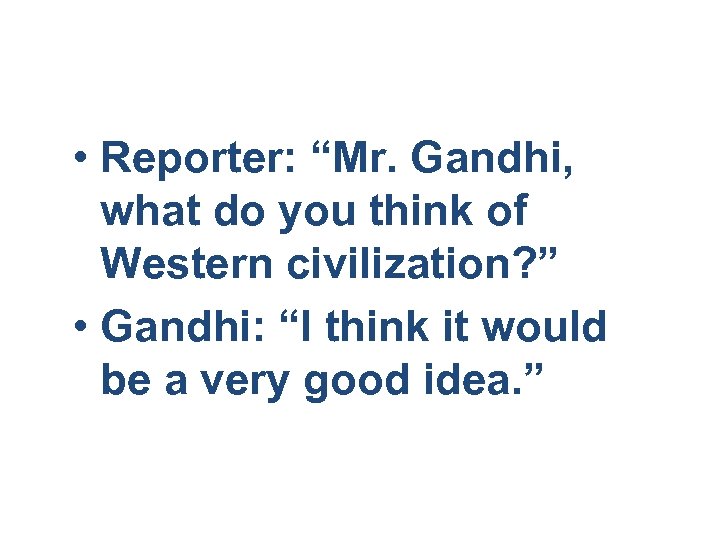 • Reporter: “Mr. Gandhi, what do you think of Western civilization? ” • Gandhi: “I think it would be a very good idea. ”
• Reporter: “Mr. Gandhi, what do you think of Western civilization? ” • Gandhi: “I think it would be a very good idea. ”
 Pair-Share Activity • What did Gandhi mean by that? • Give two examples of specific things the British did in India that support Gandhi’s ironic statement.
Pair-Share Activity • What did Gandhi mean by that? • Give two examples of specific things the British did in India that support Gandhi’s ironic statement.
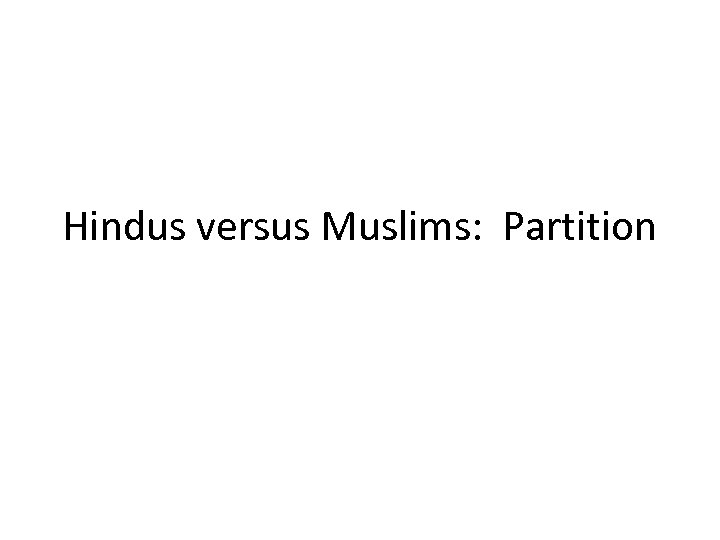 Hindus versus Muslims: Partition
Hindus versus Muslims: Partition
 ______ = (Christians, Buddhists, etc. ) ______ = 255 Million ______ = 95 Million
______ = (Christians, Buddhists, etc. ) ______ = 255 Million ______ = 95 Million
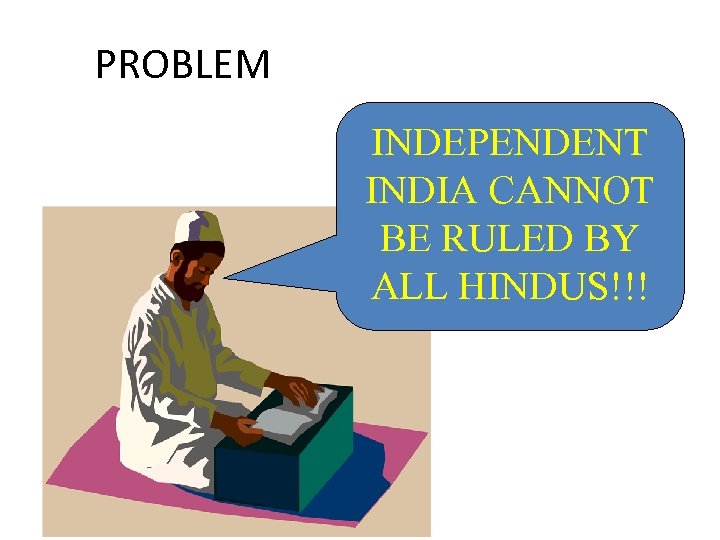 PROBLEM INDEPENDENT INDIA CANNOT BE RULED BY ALL HINDUS!!!
PROBLEM INDEPENDENT INDIA CANNOT BE RULED BY ALL HINDUS!!!
 1946 -1947 This time period was filled with violence between the Hindus and the Muslims. The result: 20 000 people either dead or wounded.
1946 -1947 This time period was filled with violence between the Hindus and the Muslims. The result: 20 000 people either dead or wounded.
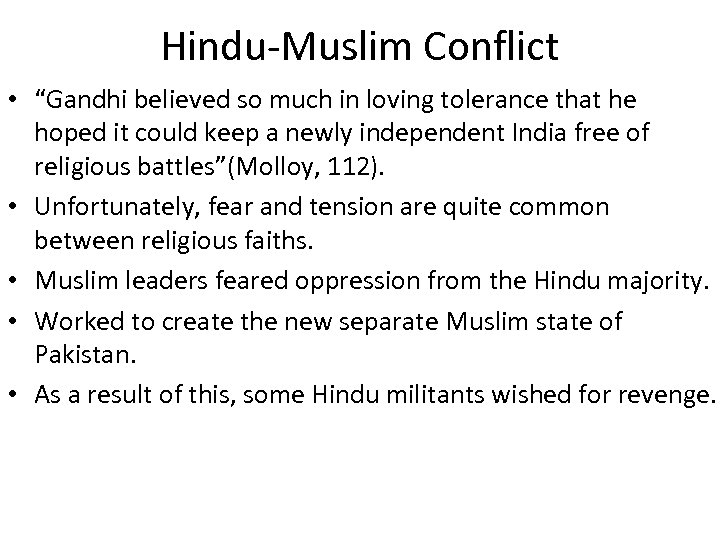 Hindu-Muslim Conflict • “Gandhi believed so much in loving tolerance that he hoped it could keep a newly independent India free of religious battles”(Molloy, 112). • Unfortunately, fear and tension are quite common between religious faiths. • Muslim leaders feared oppression from the Hindu majority. • Worked to create the new separate Muslim state of Pakistan. • As a result of this, some Hindu militants wished for revenge.
Hindu-Muslim Conflict • “Gandhi believed so much in loving tolerance that he hoped it could keep a newly independent India free of religious battles”(Molloy, 112). • Unfortunately, fear and tension are quite common between religious faiths. • Muslim leaders feared oppression from the Hindu majority. • Worked to create the new separate Muslim state of Pakistan. • As a result of this, some Hindu militants wished for revenge.
 Hindu- Muslim Conflict • Hindus and Muslims had cooperated in the nationalist movement • G. B. encouraged their divisions to weaken their grip over the region • The Muslim League, led by Muhammad Ali Jinnah, asked for a separate Muslim state • Religious differences caused a clash between the Muslims and Hindus • Also, some Muslims feared for their rights to be dominated by a Hindu majority • Gandhi thought the groups could live together, if they respected each other and treated each other as family • Hindus distrusted the Muslims and looked at them as foreign conquerors • Economic and political differences also increased the tension
Hindu- Muslim Conflict • Hindus and Muslims had cooperated in the nationalist movement • G. B. encouraged their divisions to weaken their grip over the region • The Muslim League, led by Muhammad Ali Jinnah, asked for a separate Muslim state • Religious differences caused a clash between the Muslims and Hindus • Also, some Muslims feared for their rights to be dominated by a Hindu majority • Gandhi thought the groups could live together, if they respected each other and treated each other as family • Hindus distrusted the Muslims and looked at them as foreign conquerors • Economic and political differences also increased the tension
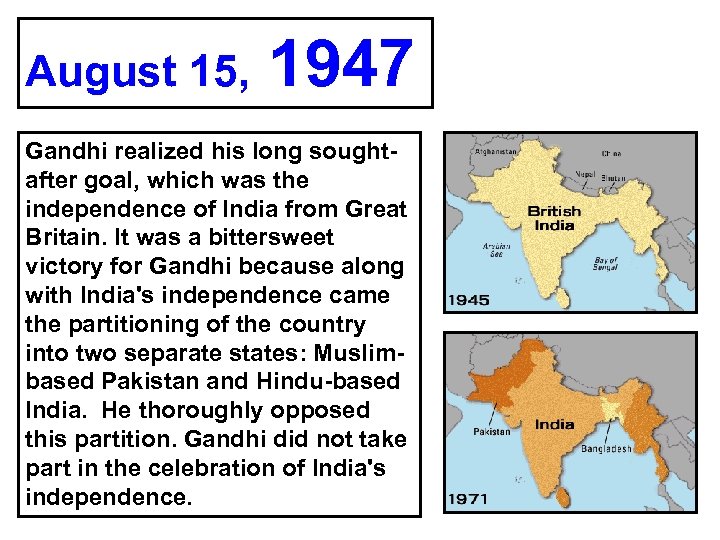 August 15, 1947 Gandhi realized his long soughtafter goal, which was the independence of India from Great Britain. It was a bittersweet victory for Gandhi because along with India's independence came the partitioning of the country into two separate states: Muslimbased Pakistan and Hindu-based India. He thoroughly opposed this partition. Gandhi did not take part in the celebration of India's independence.
August 15, 1947 Gandhi realized his long soughtafter goal, which was the independence of India from Great Britain. It was a bittersweet victory for Gandhi because along with India's independence came the partitioning of the country into two separate states: Muslimbased Pakistan and Hindu-based India. He thoroughly opposed this partition. Gandhi did not take part in the celebration of India's independence.
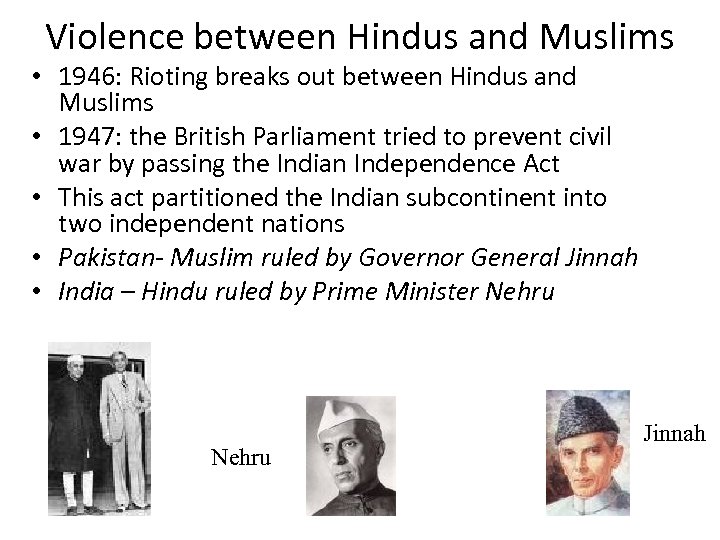 Violence between Hindus and Muslims • 1946: Rioting breaks out between Hindus and Muslims • 1947: the British Parliament tried to prevent civil war by passing the Indian Independence Act • This act partitioned the Indian subcontinent into two independent nations • Pakistan- Muslim ruled by Governor General Jinnah • India – Hindu ruled by Prime Minister Nehru Jinnah
Violence between Hindus and Muslims • 1946: Rioting breaks out between Hindus and Muslims • 1947: the British Parliament tried to prevent civil war by passing the Indian Independence Act • This act partitioned the Indian subcontinent into two independent nations • Pakistan- Muslim ruled by Governor General Jinnah • India – Hindu ruled by Prime Minister Nehru Jinnah
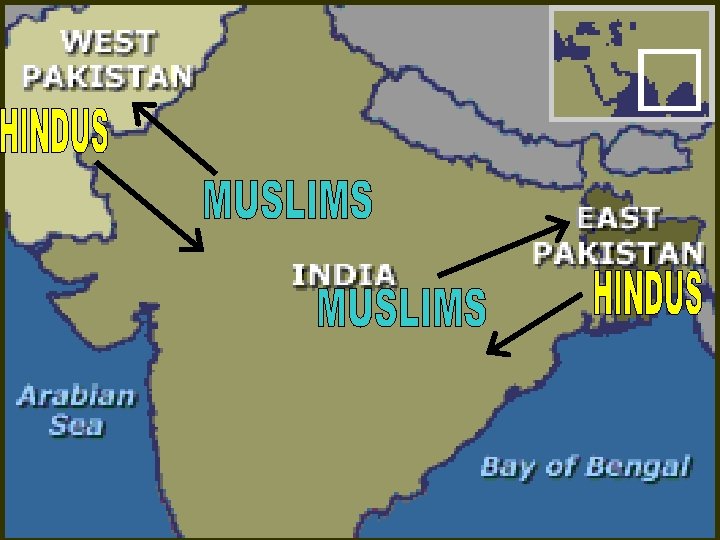
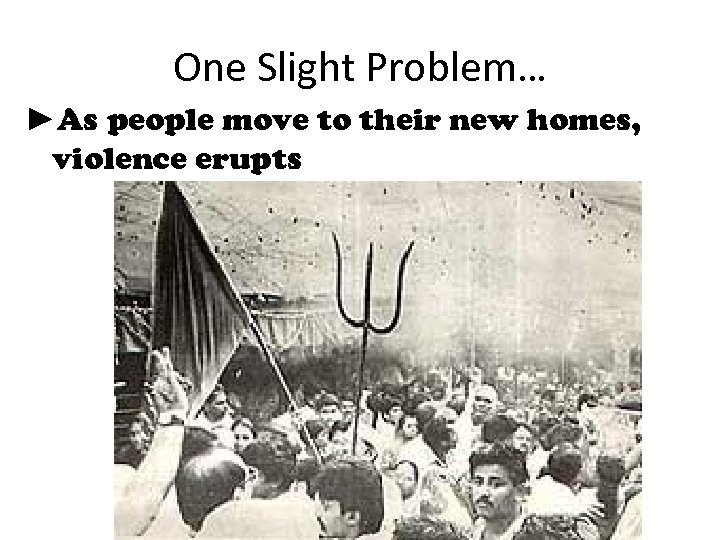 One Slight Problem… ►As people move to their new homes, violence erupts
One Slight Problem… ►As people move to their new homes, violence erupts
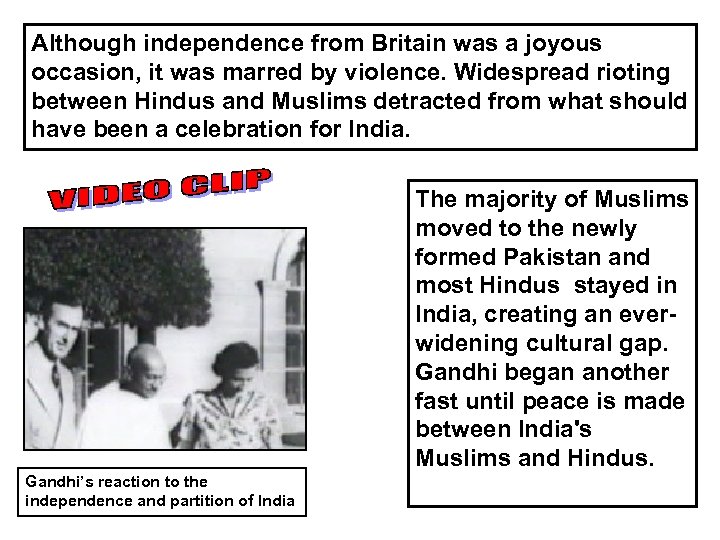 Although independence from Britain was a joyous occasion, it was marred by violence. Widespread rioting between Hindus and Muslims detracted from what should have been a celebration for India. The majority of Muslims moved to the newly formed Pakistan and most Hindus stayed in India, creating an everwidening cultural gap. Gandhi began another fast until peace is made between India's Muslims and Hindus. Gandhi’s reaction to the independence and partition of India
Although independence from Britain was a joyous occasion, it was marred by violence. Widespread rioting between Hindus and Muslims detracted from what should have been a celebration for India. The majority of Muslims moved to the newly formed Pakistan and most Hindus stayed in India, creating an everwidening cultural gap. Gandhi began another fast until peace is made between India's Muslims and Hindus. Gandhi’s reaction to the independence and partition of India
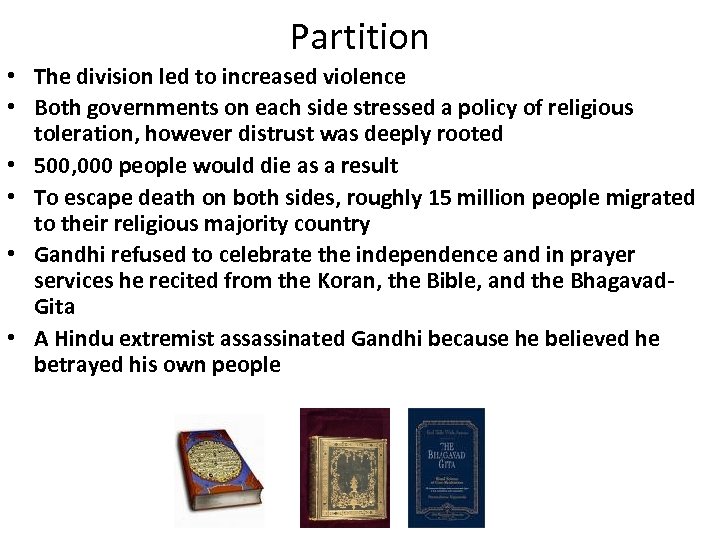 Partition • The division led to increased violence • Both governments on each side stressed a policy of religious toleration, however distrust was deeply rooted • 500, 000 people would die as a result • To escape death on both sides, roughly 15 million people migrated to their religious majority country • Gandhi refused to celebrate the independence and in prayer services he recited from the Koran, the Bible, and the Bhagavad. Gita • A Hindu extremist assassinated Gandhi because he believed he betrayed his own people
Partition • The division led to increased violence • Both governments on each side stressed a policy of religious toleration, however distrust was deeply rooted • 500, 000 people would die as a result • To escape death on both sides, roughly 15 million people migrated to their religious majority country • Gandhi refused to celebrate the independence and in prayer services he recited from the Koran, the Bible, and the Bhagavad. Gita • A Hindu extremist assassinated Gandhi because he believed he betrayed his own people
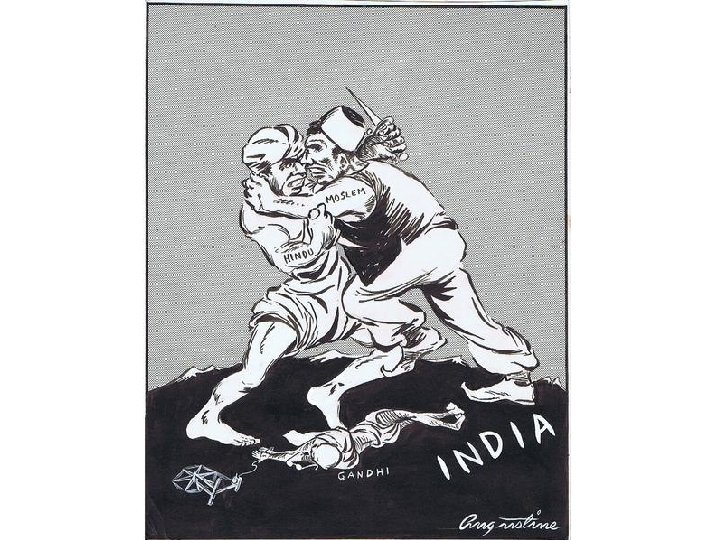
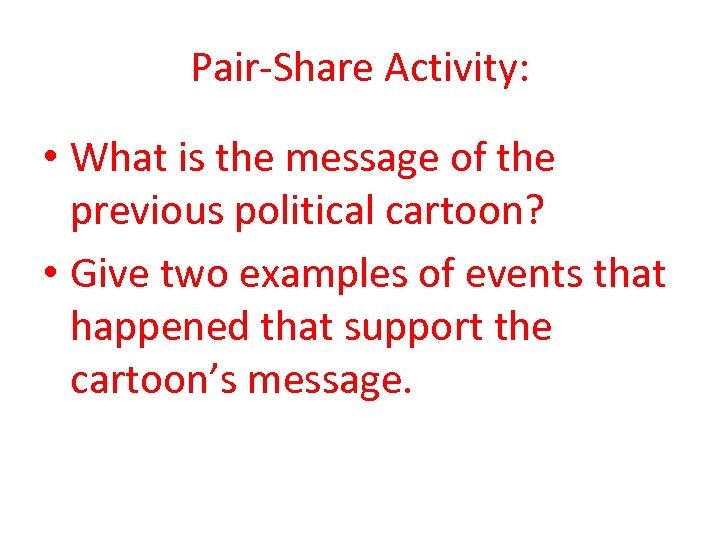 Pair-Share Activity: • What is the message of the previous political cartoon? • Give two examples of events that happened that support the cartoon’s message.
Pair-Share Activity: • What is the message of the previous political cartoon? • Give two examples of events that happened that support the cartoon’s message.
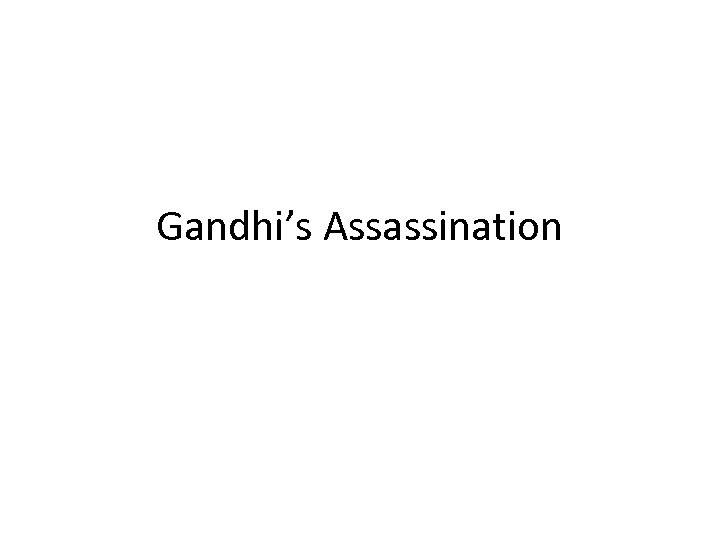 Gandhi’s Assassination
Gandhi’s Assassination
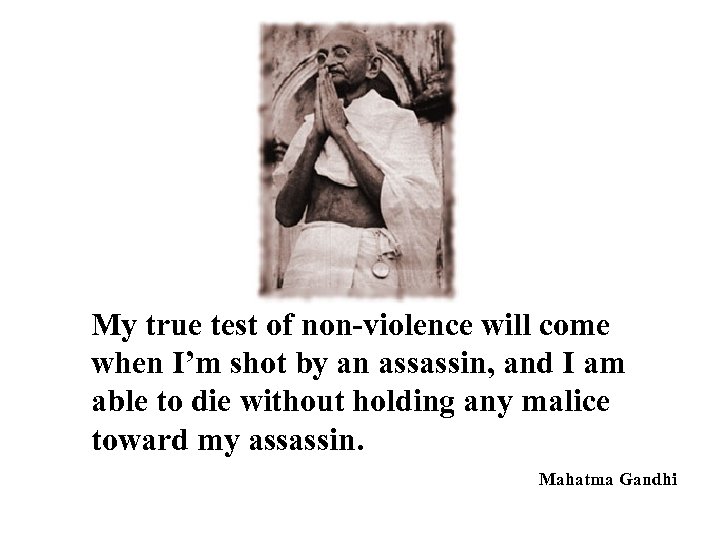 My true test of non-violence will come when I’m shot by an assassin, and I am able to die without holding any malice toward my assassin. Mahatma Gandhi
My true test of non-violence will come when I’m shot by an assassin, and I am able to die without holding any malice toward my assassin. Mahatma Gandhi
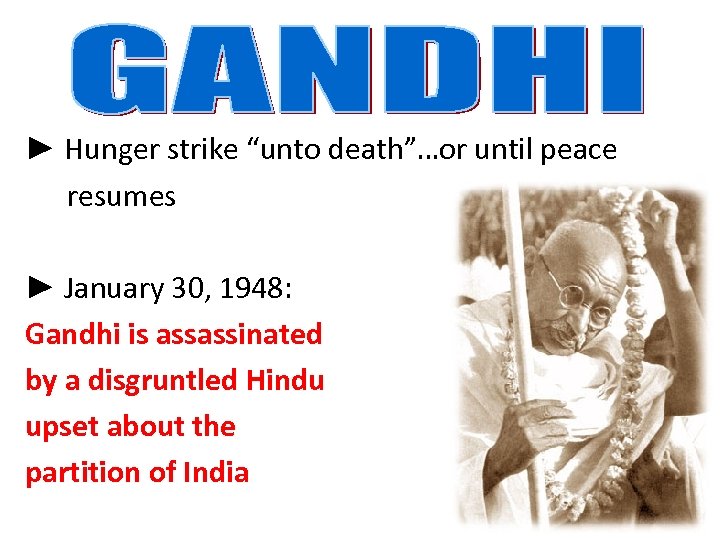 ► Hunger strike “unto death”…or until peace resumes ► January 30, 1948: Gandhi is assassinated by a disgruntled Hindu upset about the partition of India
► Hunger strike “unto death”…or until peace resumes ► January 30, 1948: Gandhi is assassinated by a disgruntled Hindu upset about the partition of India
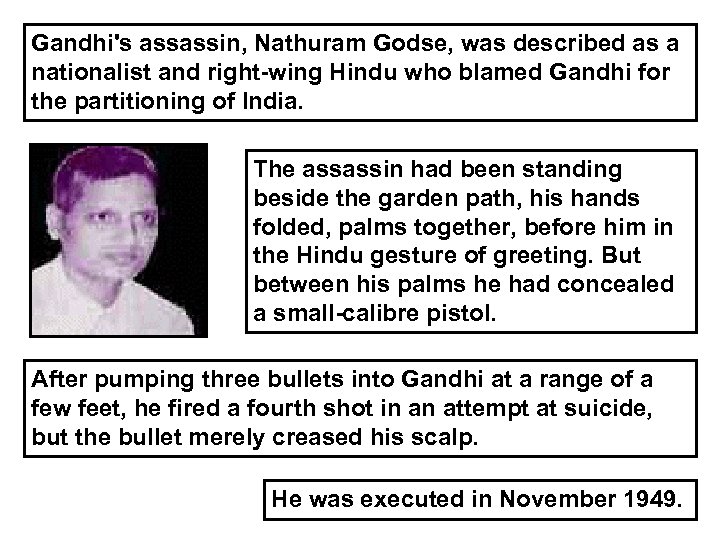 Gandhi's assassin, Nathuram Godse, was described as a nationalist and right-wing Hindu who blamed Gandhi for the partitioning of India. The assassin had been standing beside the garden path, his hands folded, palms together, before him in the Hindu gesture of greeting. But between his palms he had concealed a small-calibre pistol. After pumping three bullets into Gandhi at a range of a few feet, he fired a fourth shot in an attempt at suicide, but the bullet merely creased his scalp. He was executed in November 1949.
Gandhi's assassin, Nathuram Godse, was described as a nationalist and right-wing Hindu who blamed Gandhi for the partitioning of India. The assassin had been standing beside the garden path, his hands folded, palms together, before him in the Hindu gesture of greeting. But between his palms he had concealed a small-calibre pistol. After pumping three bullets into Gandhi at a range of a few feet, he fired a fourth shot in an attempt at suicide, but the bullet merely creased his scalp. He was executed in November 1949.
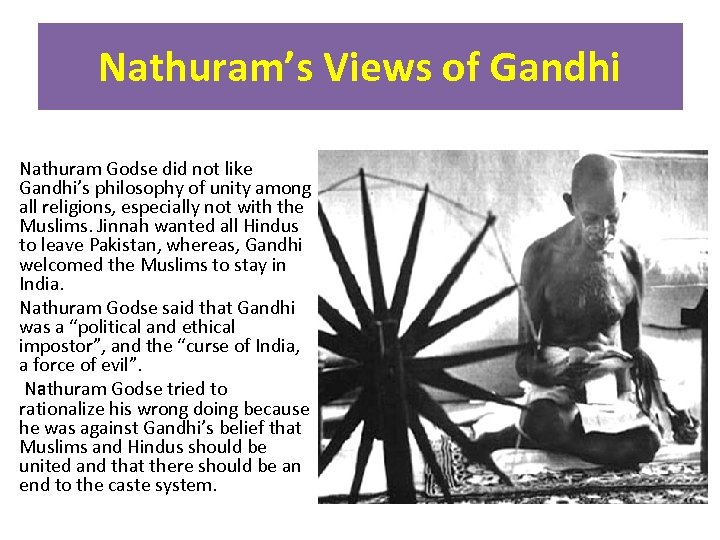 Nathuram’s Views of Gandhi Nathuram Godse did not like Gandhi’s philosophy of unity among all religions, especially not with the Muslims. Jinnah wanted all Hindus to leave Pakistan, whereas, Gandhi welcomed the Muslims to stay in India. Nathuram Godse said that Gandhi was a “political and ethical impostor”, and the “curse of India, a force of evil”. Nathuram Godse tried to rationalize his wrong doing because he was against Gandhi’s belief that Muslims and Hindus should be united and that there should be an end to the caste system.
Nathuram’s Views of Gandhi Nathuram Godse did not like Gandhi’s philosophy of unity among all religions, especially not with the Muslims. Jinnah wanted all Hindus to leave Pakistan, whereas, Gandhi welcomed the Muslims to stay in India. Nathuram Godse said that Gandhi was a “political and ethical impostor”, and the “curse of India, a force of evil”. Nathuram Godse tried to rationalize his wrong doing because he was against Gandhi’s belief that Muslims and Hindus should be united and that there should be an end to the caste system.
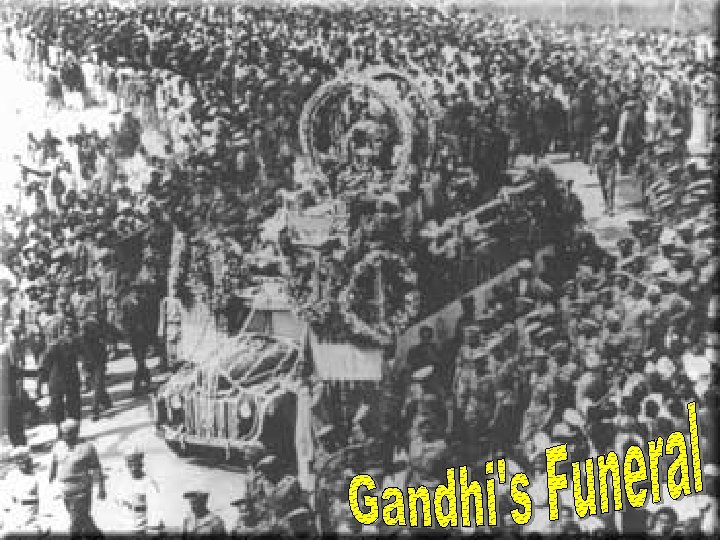
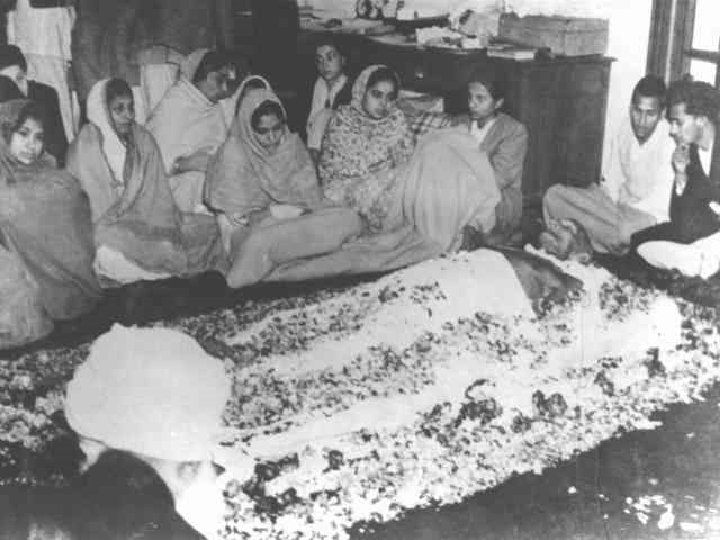
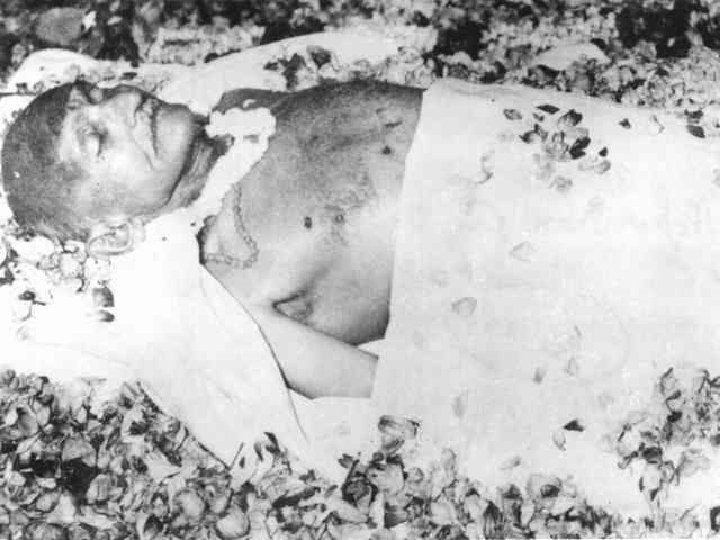
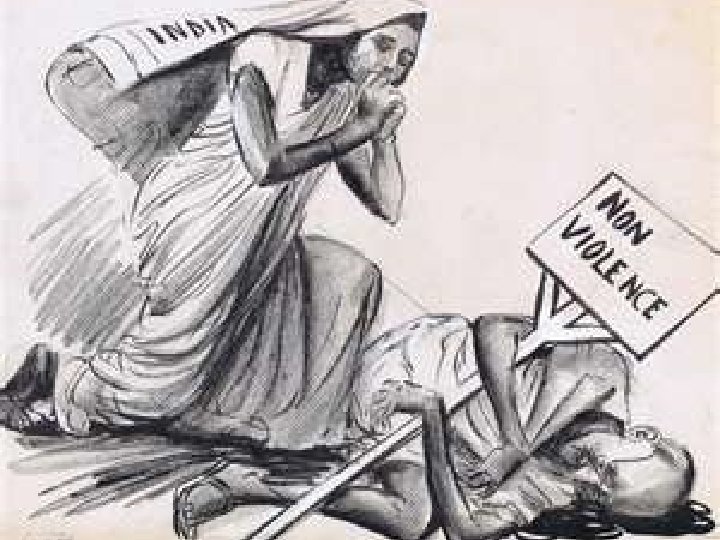
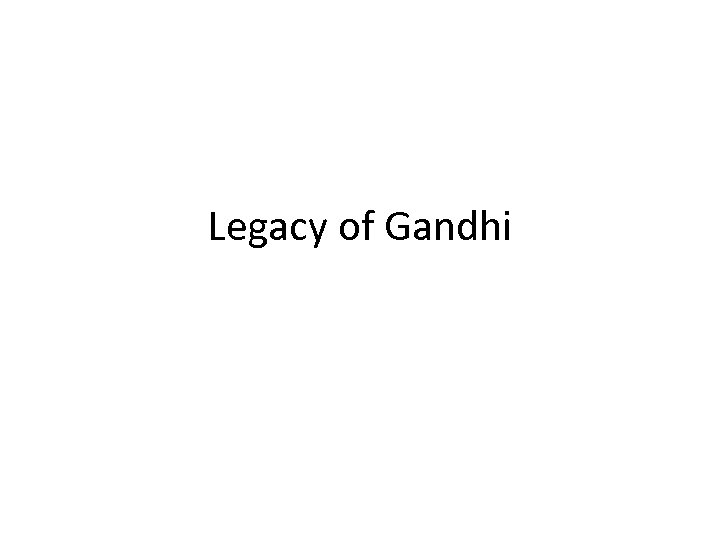 Legacy of Gandhi
Legacy of Gandhi
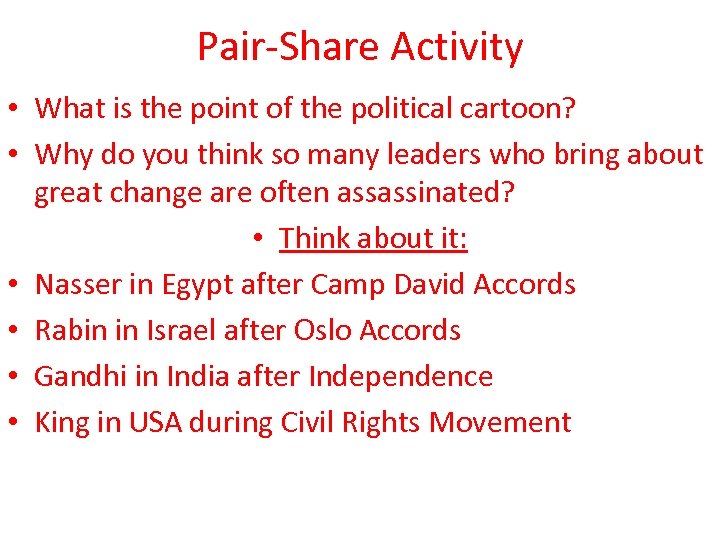 Pair-Share Activity • What is the point of the political cartoon? • Why do you think so many leaders who bring about great change are often assassinated? • Think about it: • Nasser in Egypt after Camp David Accords • Rabin in Israel after Oslo Accords • Gandhi in India after Independence • King in USA during Civil Rights Movement
Pair-Share Activity • What is the point of the political cartoon? • Why do you think so many leaders who bring about great change are often assassinated? • Think about it: • Nasser in Egypt after Camp David Accords • Rabin in Israel after Oslo Accords • Gandhi in India after Independence • King in USA during Civil Rights Movement
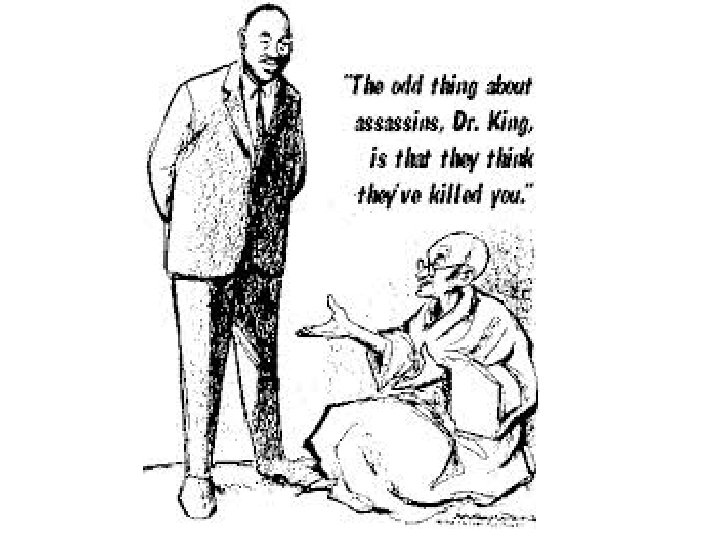
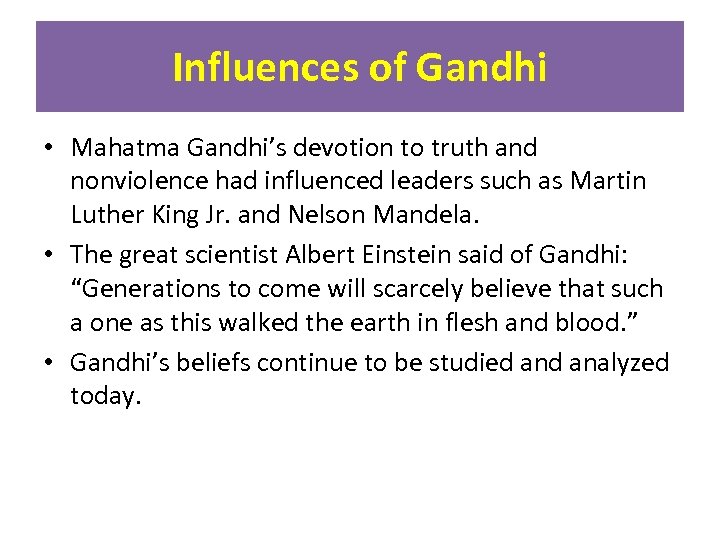 Influences of Gandhi • Mahatma Gandhi’s devotion to truth and nonviolence had influenced leaders such as Martin Luther King Jr. and Nelson Mandela. • The great scientist Albert Einstein said of Gandhi: “Generations to come will scarcely believe that such a one as this walked the earth in flesh and blood. ” • Gandhi’s beliefs continue to be studied analyzed today.
Influences of Gandhi • Mahatma Gandhi’s devotion to truth and nonviolence had influenced leaders such as Martin Luther King Jr. and Nelson Mandela. • The great scientist Albert Einstein said of Gandhi: “Generations to come will scarcely believe that such a one as this walked the earth in flesh and blood. ” • Gandhi’s beliefs continue to be studied analyzed today.
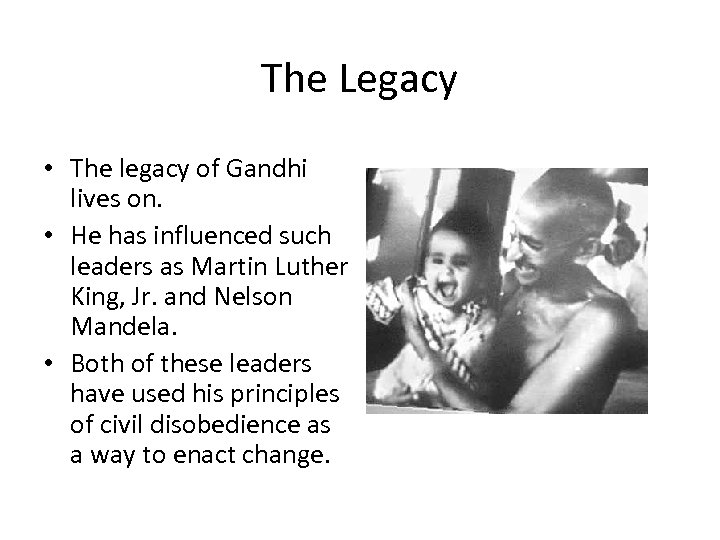 The Legacy • The legacy of Gandhi lives on. • He has influenced such leaders as Martin Luther King, Jr. and Nelson Mandela. • Both of these leaders have used his principles of civil disobedience as a way to enact change.
The Legacy • The legacy of Gandhi lives on. • He has influenced such leaders as Martin Luther King, Jr. and Nelson Mandela. • Both of these leaders have used his principles of civil disobedience as a way to enact change.
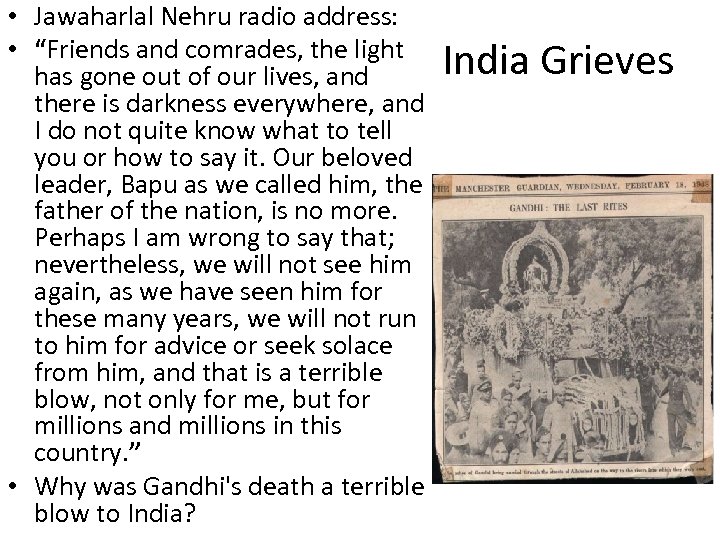 • Jawaharlal Nehru radio address: • “Friends and comrades, the light has gone out of our lives, and there is darkness everywhere, and I do not quite know what to tell you or how to say it. Our beloved leader, Bapu as we called him, the father of the nation, is no more. Perhaps I am wrong to say that; nevertheless, we will not see him again, as we have seen him for these many years, we will not run to him for advice or seek solace from him, and that is a terrible blow, not only for me, but for millions and millions in this country. ” • Why was Gandhi's death a terrible blow to India? India Grieves
• Jawaharlal Nehru radio address: • “Friends and comrades, the light has gone out of our lives, and there is darkness everywhere, and I do not quite know what to tell you or how to say it. Our beloved leader, Bapu as we called him, the father of the nation, is no more. Perhaps I am wrong to say that; nevertheless, we will not see him again, as we have seen him for these many years, we will not run to him for advice or seek solace from him, and that is a terrible blow, not only for me, but for millions and millions in this country. ” • Why was Gandhi's death a terrible blow to India? India Grieves
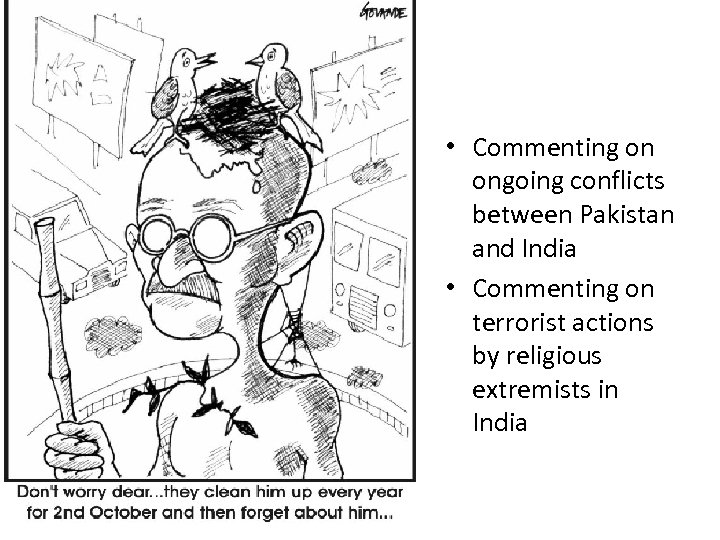 • Commenting on ongoing conflicts between Pakistan and India • Commenting on terrorist actions by religious extremists in India
• Commenting on ongoing conflicts between Pakistan and India • Commenting on terrorist actions by religious extremists in India
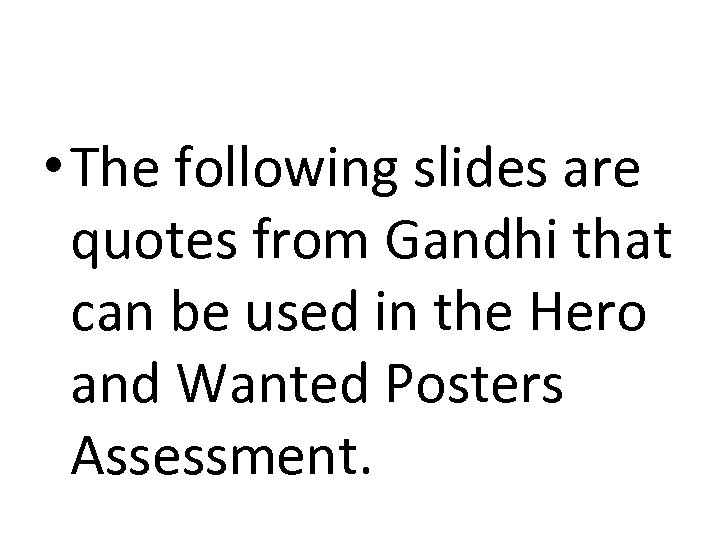 • The following slides are quotes from Gandhi that can be used in the Hero and Wanted Posters Assessment.
• The following slides are quotes from Gandhi that can be used in the Hero and Wanted Posters Assessment.
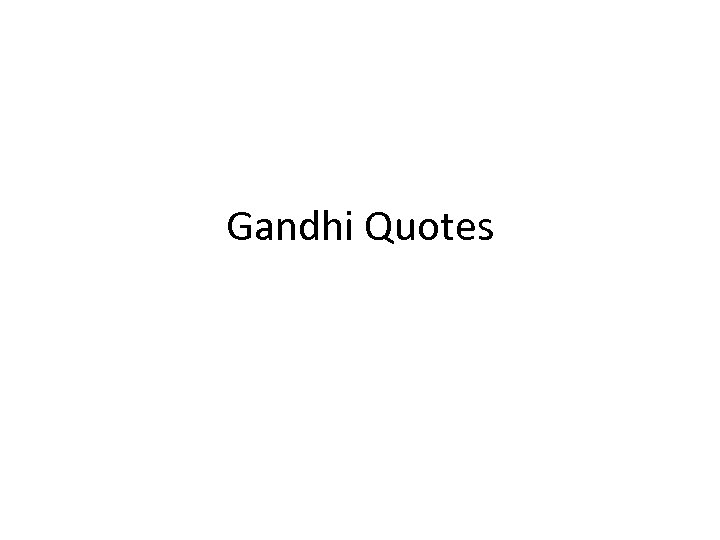 Gandhi Quotes
Gandhi Quotes
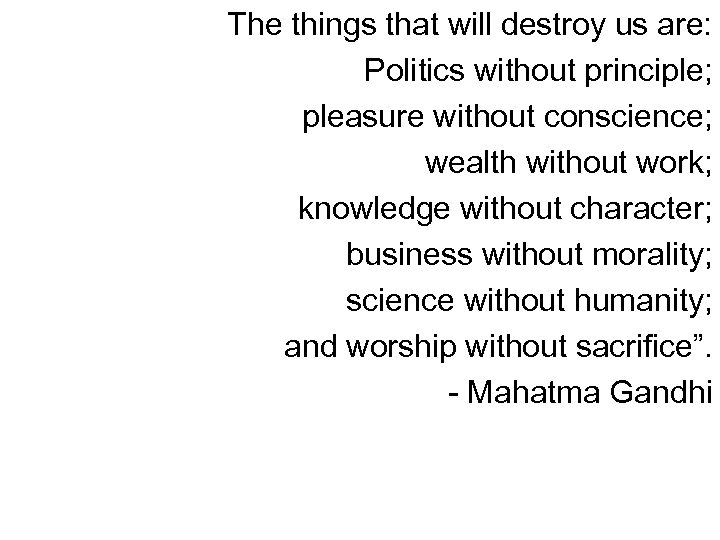 The things that will destroy us are: Politics without principle; pleasure without conscience; wealth without work; knowledge without character; business without morality; science without humanity; and worship without sacrifice”. - Mahatma Gandhi
The things that will destroy us are: Politics without principle; pleasure without conscience; wealth without work; knowledge without character; business without morality; science without humanity; and worship without sacrifice”. - Mahatma Gandhi
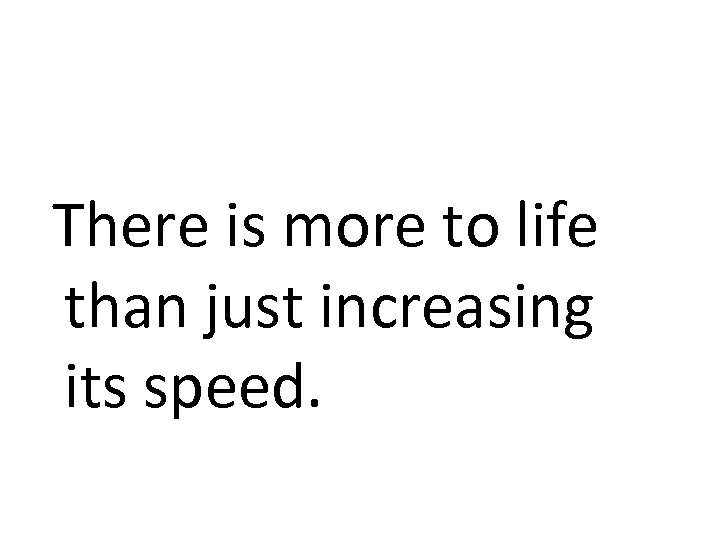 There is more to life than just increasing its speed.
There is more to life than just increasing its speed.
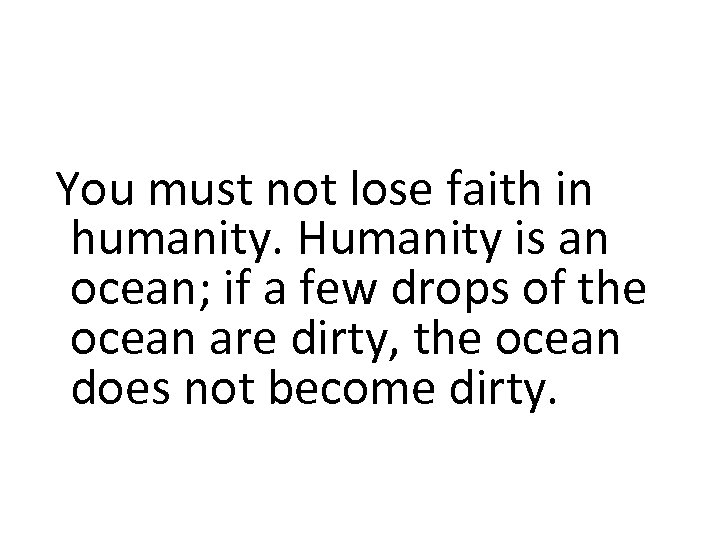 You must not lose faith in humanity. Humanity is an ocean; if a few drops of the ocean are dirty, the ocean does not become dirty.
You must not lose faith in humanity. Humanity is an ocean; if a few drops of the ocean are dirty, the ocean does not become dirty.
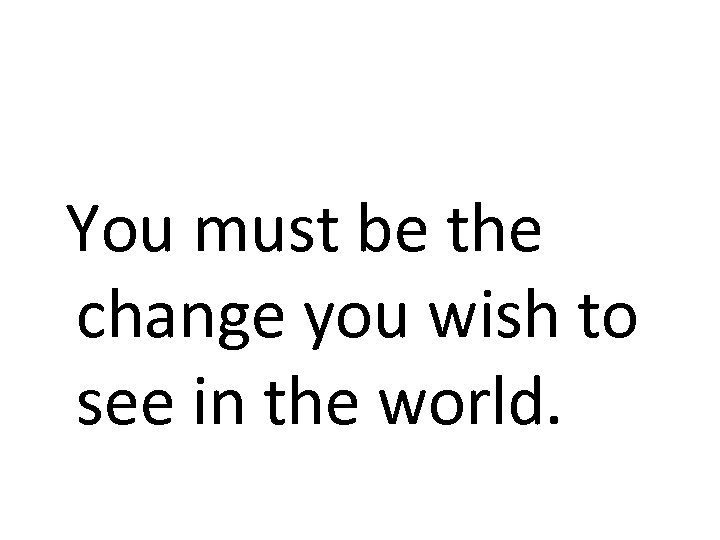 You must be the change you wish to see in the world.
You must be the change you wish to see in the world.
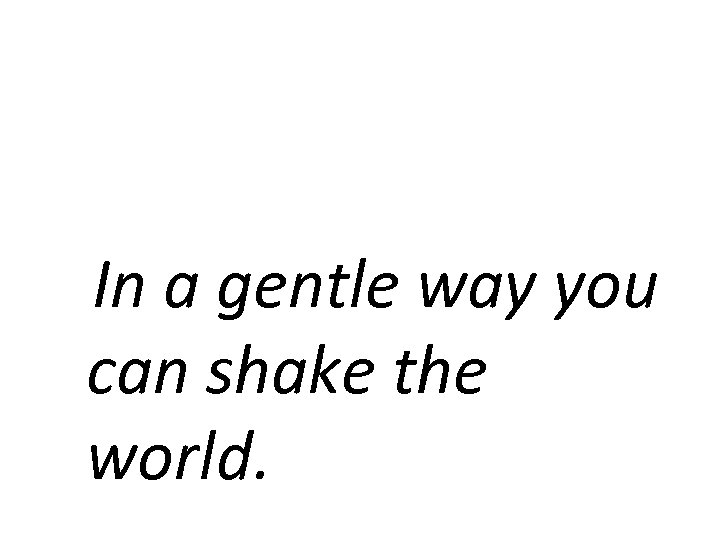 In a gentle way you can shake the world.
In a gentle way you can shake the world.
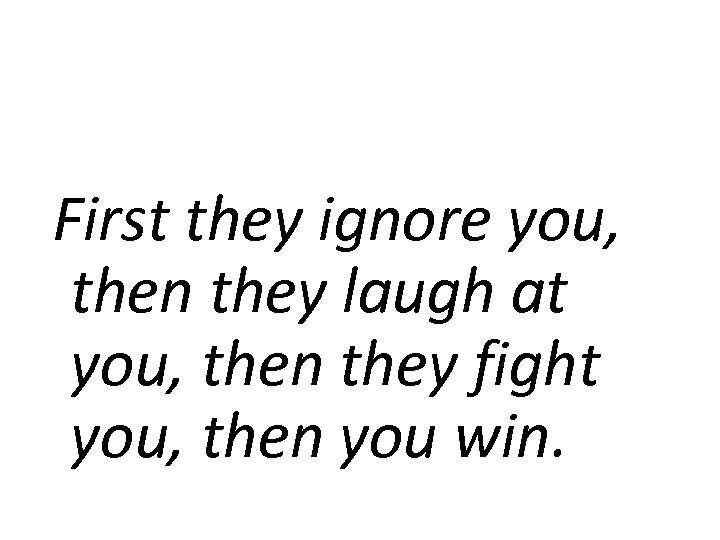 First they ignore you, then they laugh at you, then they fight you, then you win.
First they ignore you, then they laugh at you, then they fight you, then you win.
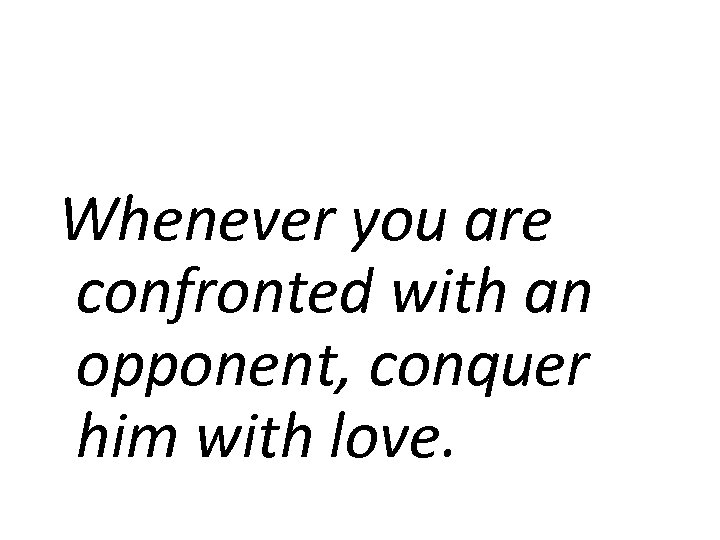 Whenever you are confronted with an opponent, conquer him with love.
Whenever you are confronted with an opponent, conquer him with love.
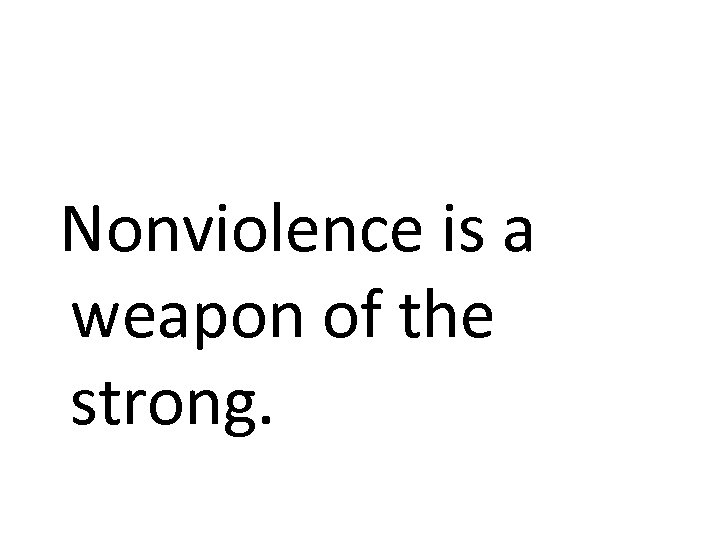 Nonviolence is a weapon of the strong.
Nonviolence is a weapon of the strong.
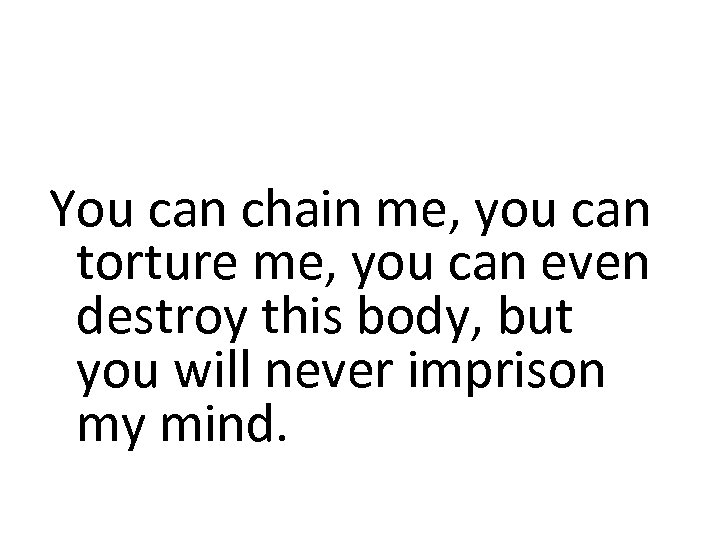 You can chain me, you can torture me, you can even destroy this body, but you will never imprison my mind.
You can chain me, you can torture me, you can even destroy this body, but you will never imprison my mind.
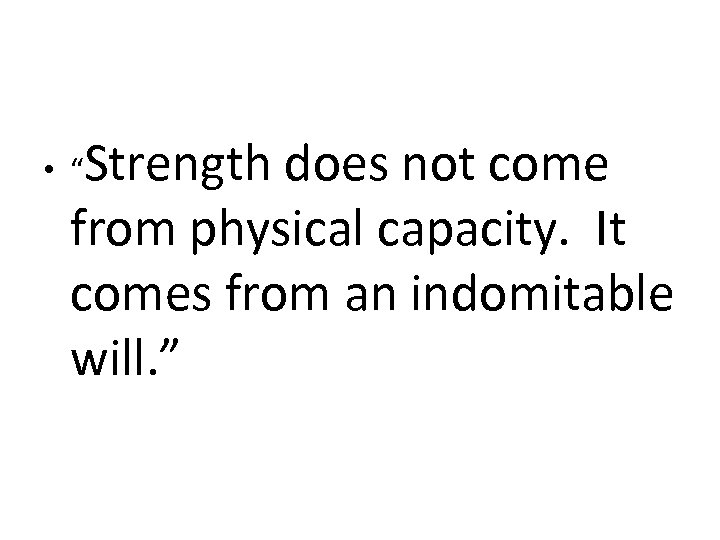 Strength does not come from physical capacity. It comes from an indomitable will. ” • “
Strength does not come from physical capacity. It comes from an indomitable will. ” • “
 For Review To Summarize Lesson
For Review To Summarize Lesson
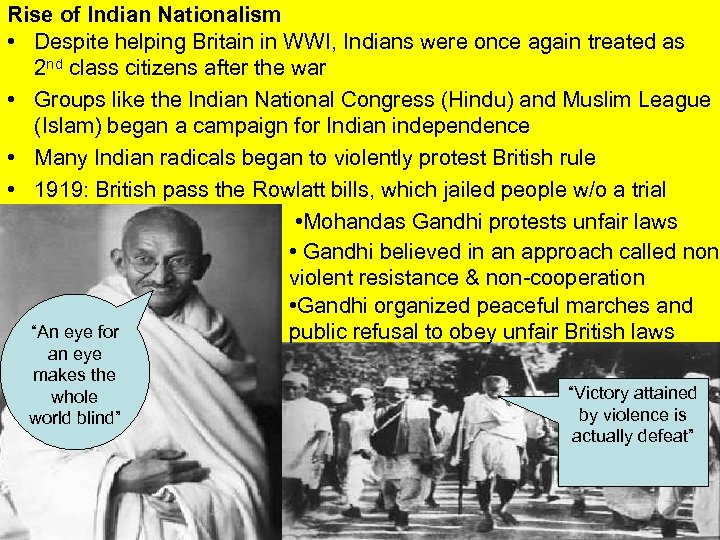 Rise of Indian Nationalism • Despite helping Britain in WWI, Indians were once again treated as 2 nd class citizens after the war • Groups like the Indian National Congress (Hindu) and Muslim League (Islam) began a campaign for Indian independence • Many Indian radicals began to violently protest British rule • 1919: British pass the Rowlatt bills, which jailed people w/o a trial • Mohandas Gandhi protests unfair laws • Gandhi believed in an approach called nonviolent resistance & non-cooperation • Gandhi organized peaceful marches and “An eye for public refusal to obey unfair British laws an eye makes the whole world blind” “Victory attained by violence is actually defeat”
Rise of Indian Nationalism • Despite helping Britain in WWI, Indians were once again treated as 2 nd class citizens after the war • Groups like the Indian National Congress (Hindu) and Muslim League (Islam) began a campaign for Indian independence • Many Indian radicals began to violently protest British rule • 1919: British pass the Rowlatt bills, which jailed people w/o a trial • Mohandas Gandhi protests unfair laws • Gandhi believed in an approach called nonviolent resistance & non-cooperation • Gandhi organized peaceful marches and “An eye for public refusal to obey unfair British laws an eye makes the whole world blind” “Victory attained by violence is actually defeat”
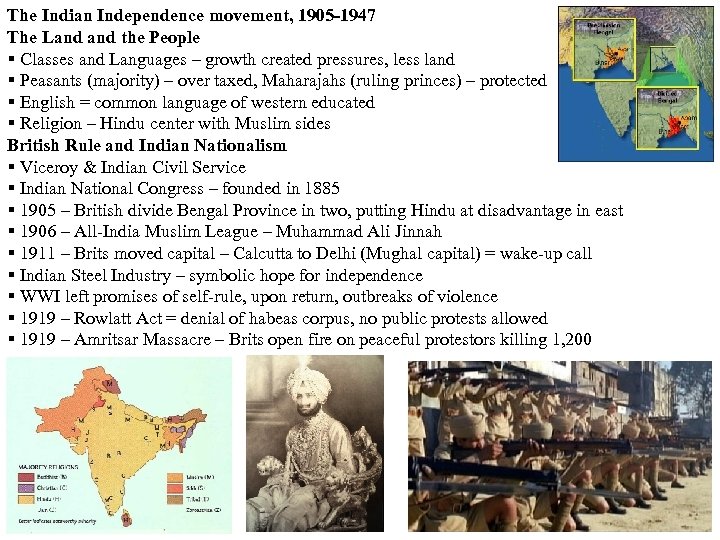 The Indian Independence movement, 1905 -1947 The Land the People Classes and Languages – growth created pressures, less land Peasants (majority) – over taxed, Maharajahs (ruling princes) – protected English = common language of western educated Religion – Hindu center with Muslim sides British Rule and Indian Nationalism Viceroy & Indian Civil Service Indian National Congress – founded in 1885 1905 – British divide Bengal Province in two, putting Hindu at disadvantage in east 1906 – All-India Muslim League – Muhammad Ali Jinnah 1911 – Brits moved capital – Calcutta to Delhi (Mughal capital) = wake-up call Indian Steel Industry – symbolic hope for independence WWI left promises of self-rule, upon return, outbreaks of violence 1919 – Rowlatt Act = denial of habeas corpus, no public protests allowed 1919 – Amritsar Massacre – Brits open fire on peaceful protestors killing 1, 200
The Indian Independence movement, 1905 -1947 The Land the People Classes and Languages – growth created pressures, less land Peasants (majority) – over taxed, Maharajahs (ruling princes) – protected English = common language of western educated Religion – Hindu center with Muslim sides British Rule and Indian Nationalism Viceroy & Indian Civil Service Indian National Congress – founded in 1885 1905 – British divide Bengal Province in two, putting Hindu at disadvantage in east 1906 – All-India Muslim League – Muhammad Ali Jinnah 1911 – Brits moved capital – Calcutta to Delhi (Mughal capital) = wake-up call Indian Steel Industry – symbolic hope for independence WWI left promises of self-rule, upon return, outbreaks of violence 1919 – Rowlatt Act = denial of habeas corpus, no public protests allowed 1919 – Amritsar Massacre – Brits open fire on peaceful protestors killing 1, 200
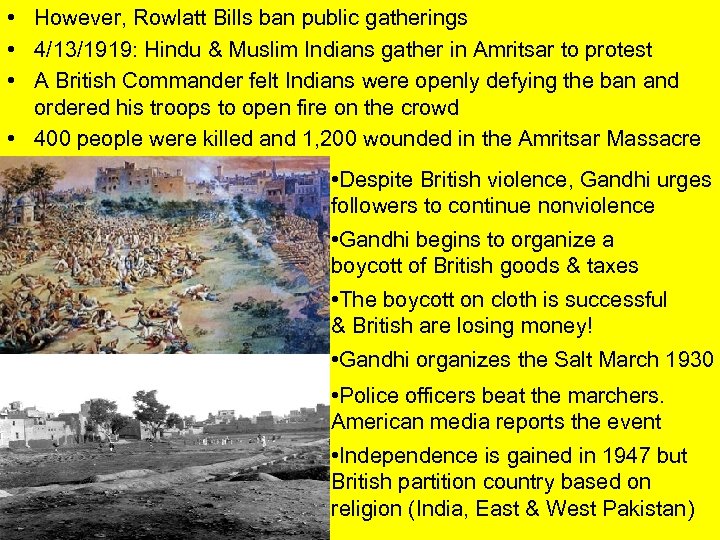 • However, Rowlatt Bills ban public gatherings • 4/13/1919: Hindu & Muslim Indians gather in Amritsar to protest • A British Commander felt Indians were openly defying the ban and ordered his troops to open fire on the crowd • 400 people were killed and 1, 200 wounded in the Amritsar Massacre • Despite British violence, Gandhi urges followers to continue nonviolence • Gandhi begins to organize a boycott of British goods & taxes • The boycott on cloth is successful & British are losing money! • Gandhi organizes the Salt March 1930 • Police officers beat the marchers. American media reports the event • Independence is gained in 1947 but British partition country based on religion (India, East & West Pakistan)
• However, Rowlatt Bills ban public gatherings • 4/13/1919: Hindu & Muslim Indians gather in Amritsar to protest • A British Commander felt Indians were openly defying the ban and ordered his troops to open fire on the crowd • 400 people were killed and 1, 200 wounded in the Amritsar Massacre • Despite British violence, Gandhi urges followers to continue nonviolence • Gandhi begins to organize a boycott of British goods & taxes • The boycott on cloth is successful & British are losing money! • Gandhi organizes the Salt March 1930 • Police officers beat the marchers. American media reports the event • Independence is gained in 1947 but British partition country based on religion (India, East & West Pakistan)
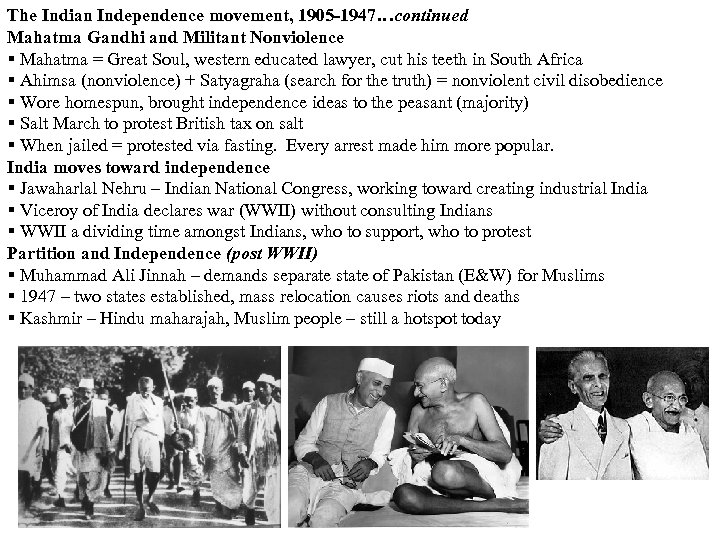 The Indian Independence movement, 1905 -1947…continued 1905 -1947 Mahatma Gandhi and Militant Nonviolence Mahatma = Great Soul, western educated lawyer, cut his teeth in South Africa Ahimsa (nonviolence) + Satyagraha (search for the truth) = nonviolent civil disobedience Wore homespun, brought independence ideas to the peasant (majority) Salt March to protest British tax on salt When jailed = protested via fasting. Every arrest made him more popular. India moves toward independence Jawaharlal Nehru – Indian National Congress, working toward creating industrial India Viceroy of India declares war (WWII) without consulting Indians WWII a dividing time amongst Indians, who to support, who to protest Partition and Independence (post WWII) Muhammad Ali Jinnah – demands separate state of Pakistan (E&W) for Muslims 1947 – two states established, mass relocation causes riots and deaths Kashmir – Hindu maharajah, Muslim people – still a hotspot today
The Indian Independence movement, 1905 -1947…continued 1905 -1947 Mahatma Gandhi and Militant Nonviolence Mahatma = Great Soul, western educated lawyer, cut his teeth in South Africa Ahimsa (nonviolence) + Satyagraha (search for the truth) = nonviolent civil disobedience Wore homespun, brought independence ideas to the peasant (majority) Salt March to protest British tax on salt When jailed = protested via fasting. Every arrest made him more popular. India moves toward independence Jawaharlal Nehru – Indian National Congress, working toward creating industrial India Viceroy of India declares war (WWII) without consulting Indians WWII a dividing time amongst Indians, who to support, who to protest Partition and Independence (post WWII) Muhammad Ali Jinnah – demands separate state of Pakistan (E&W) for Muslims 1947 – two states established, mass relocation causes riots and deaths Kashmir – Hindu maharajah, Muslim people – still a hotspot today


